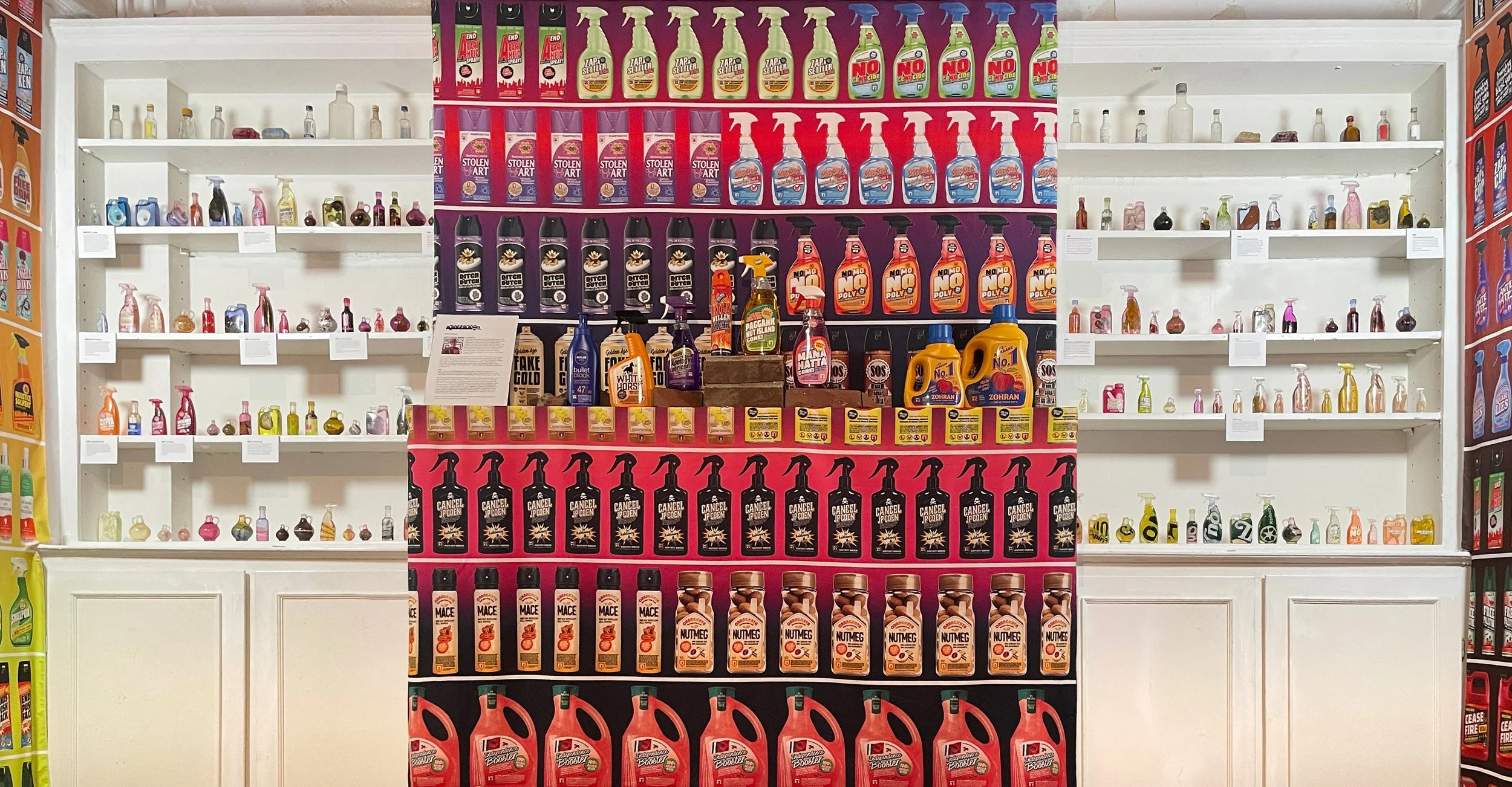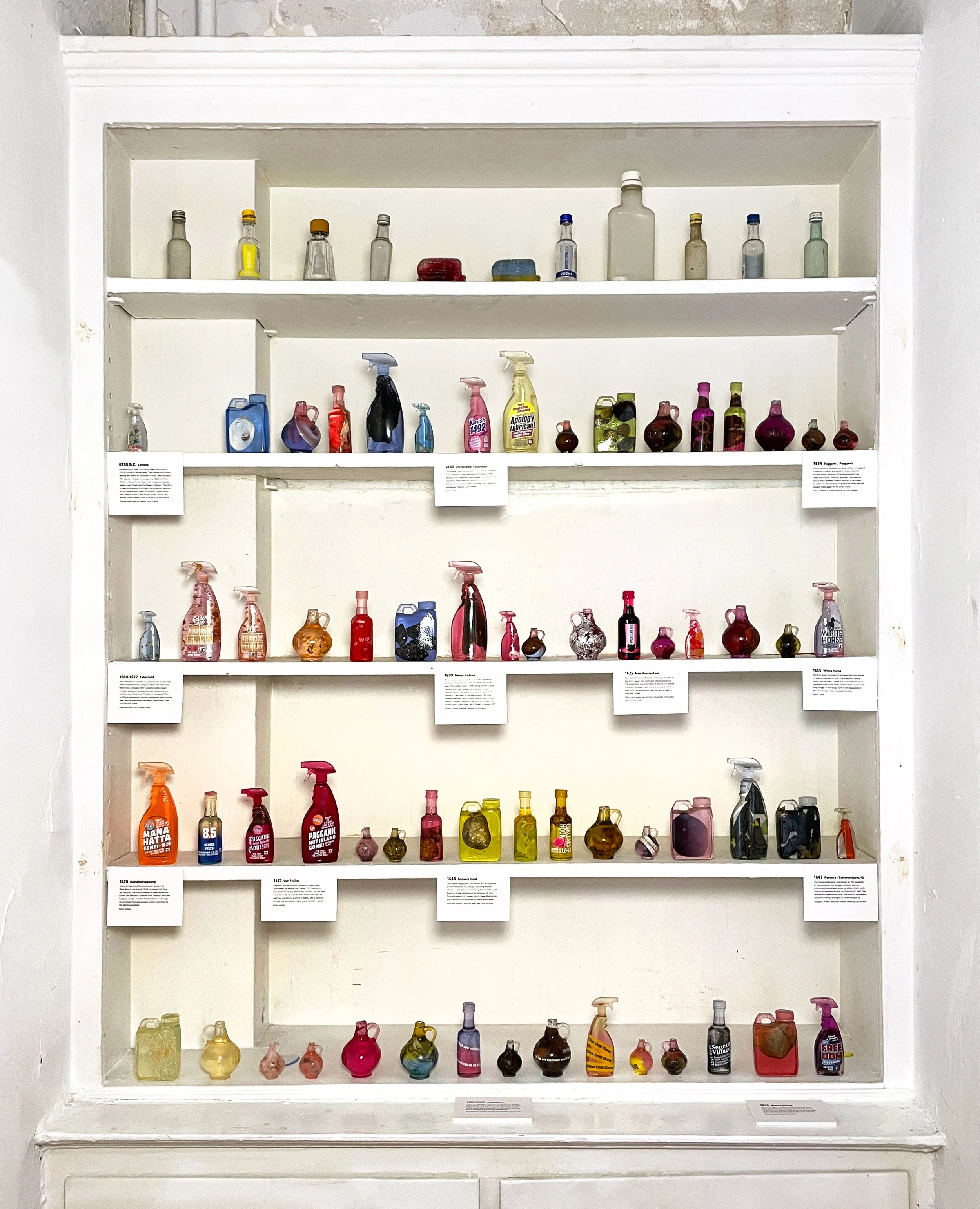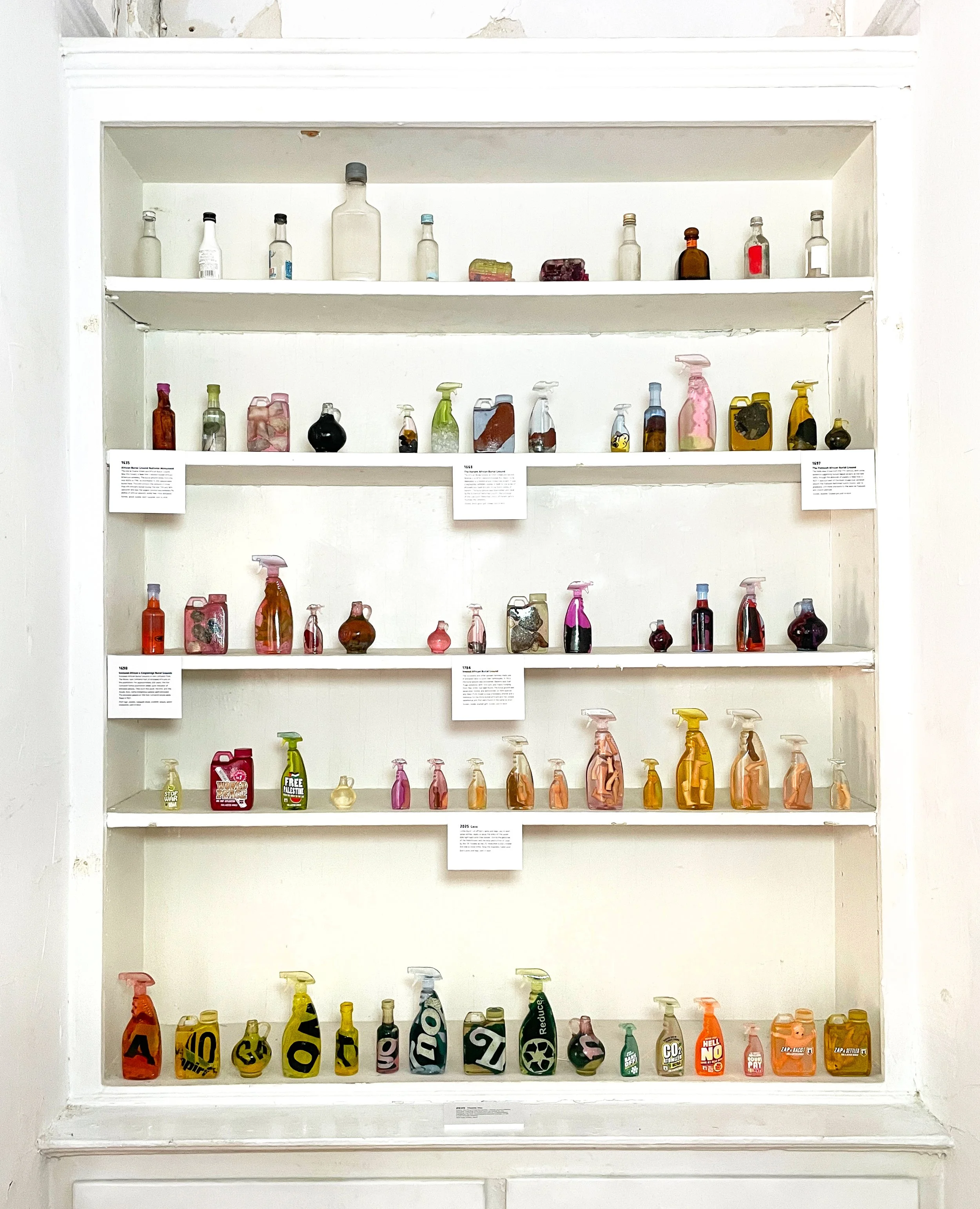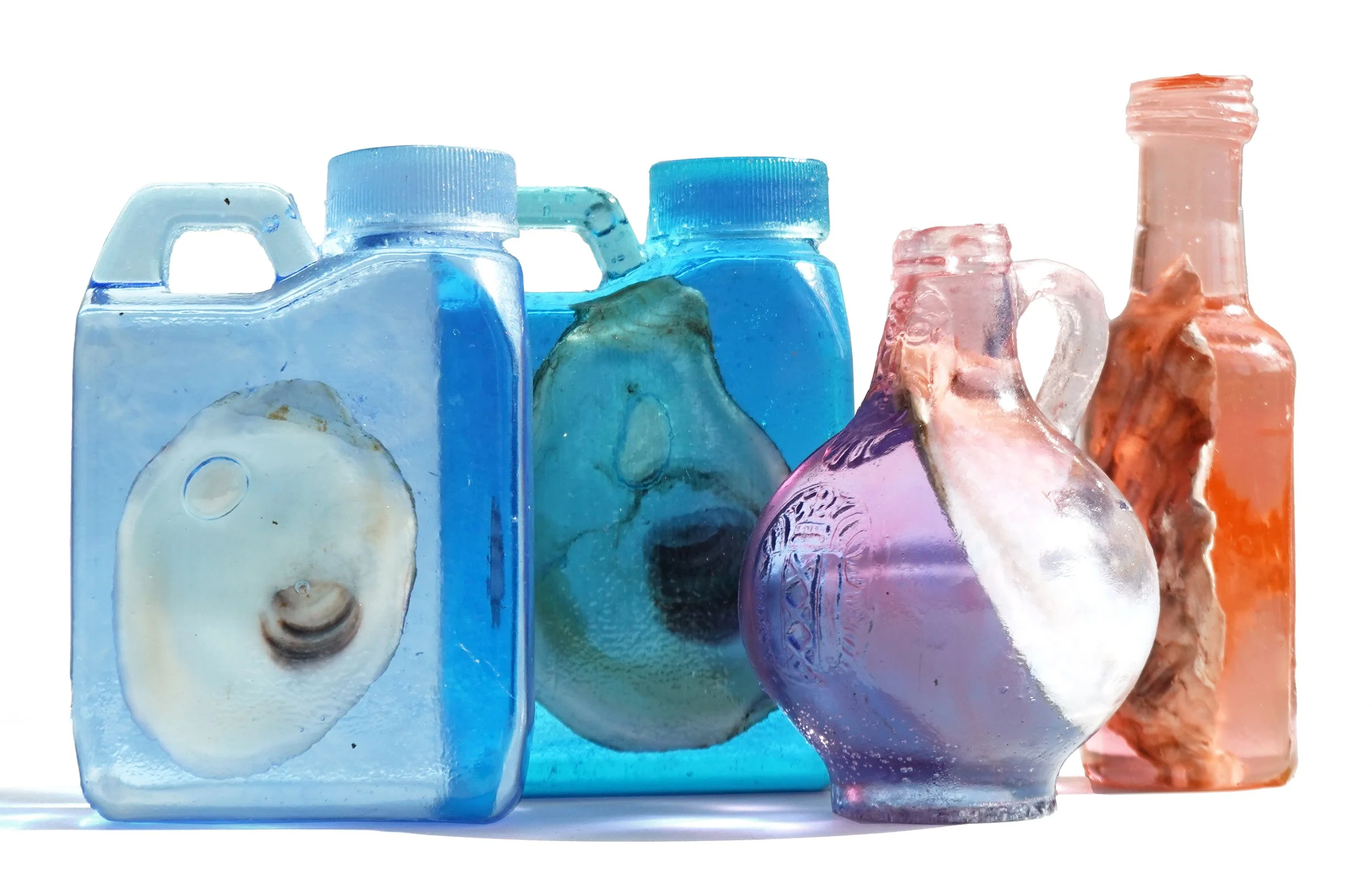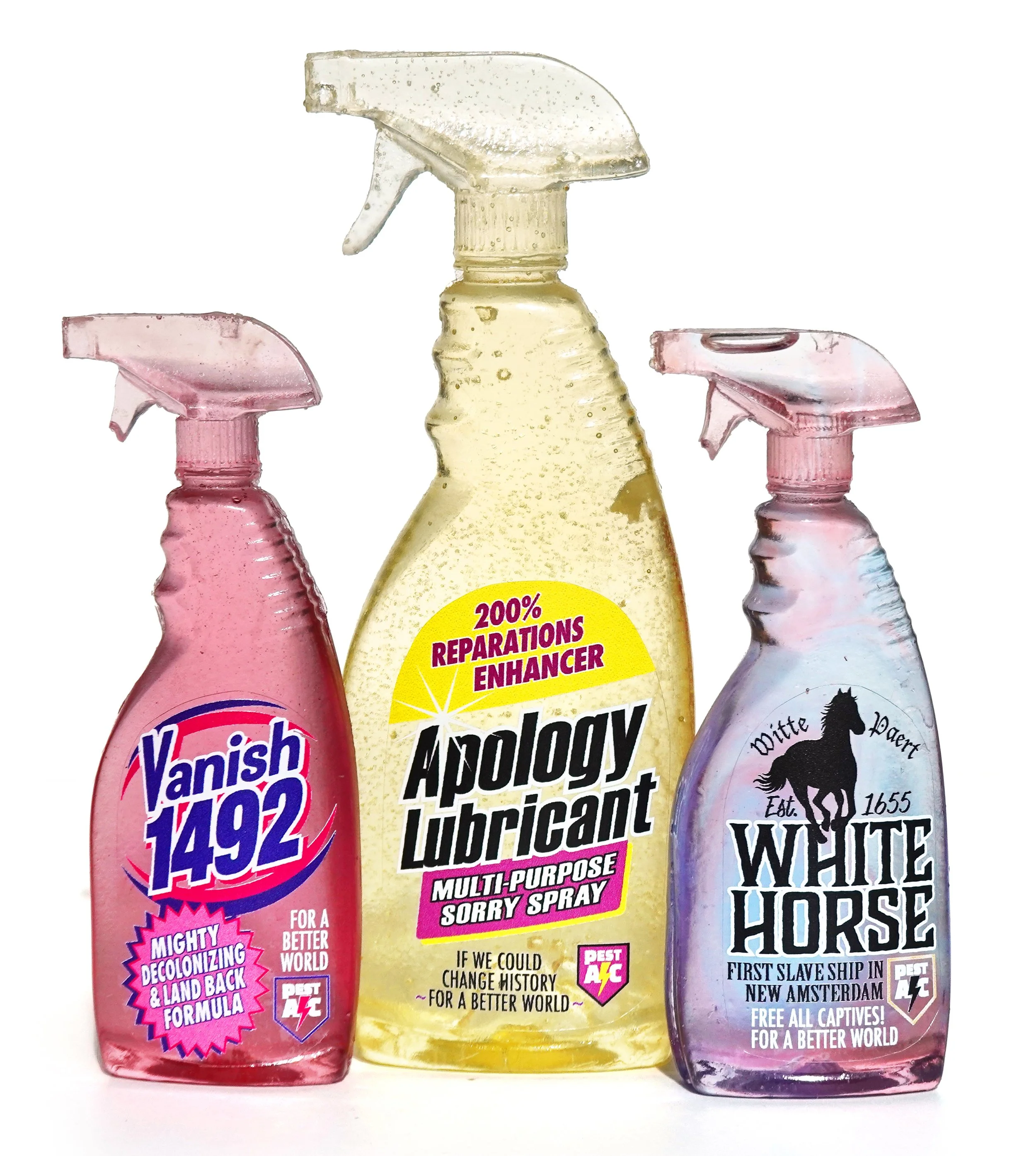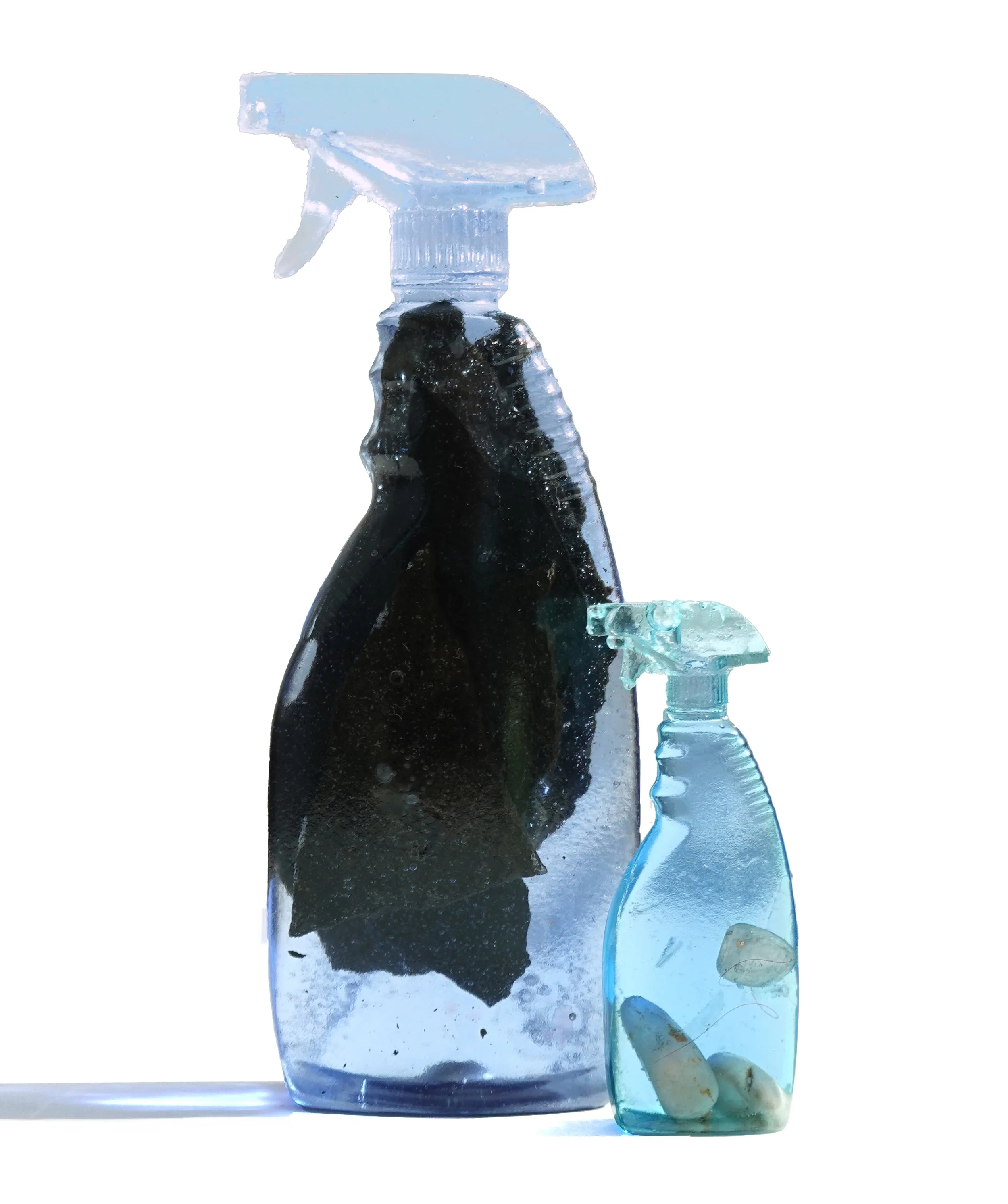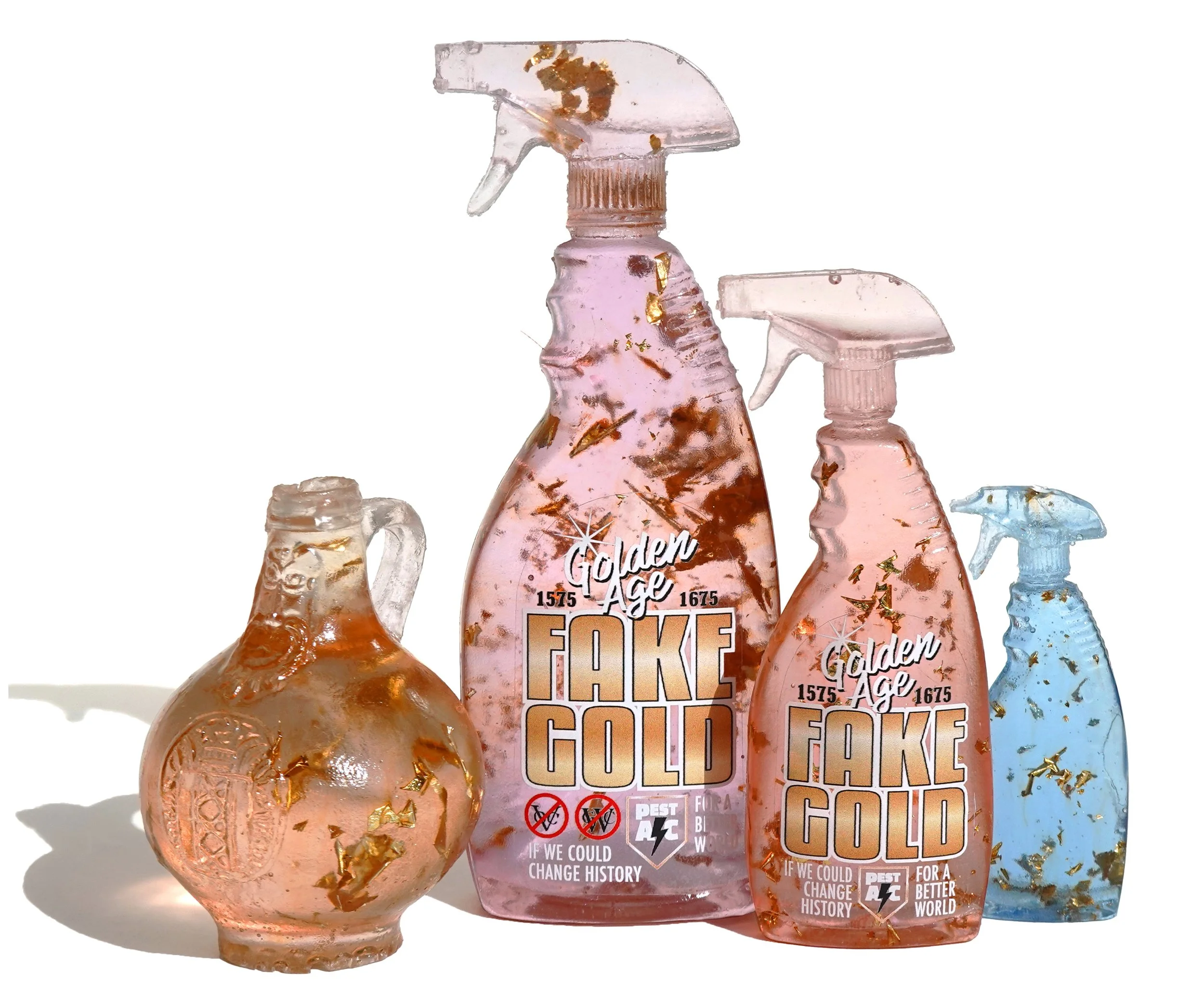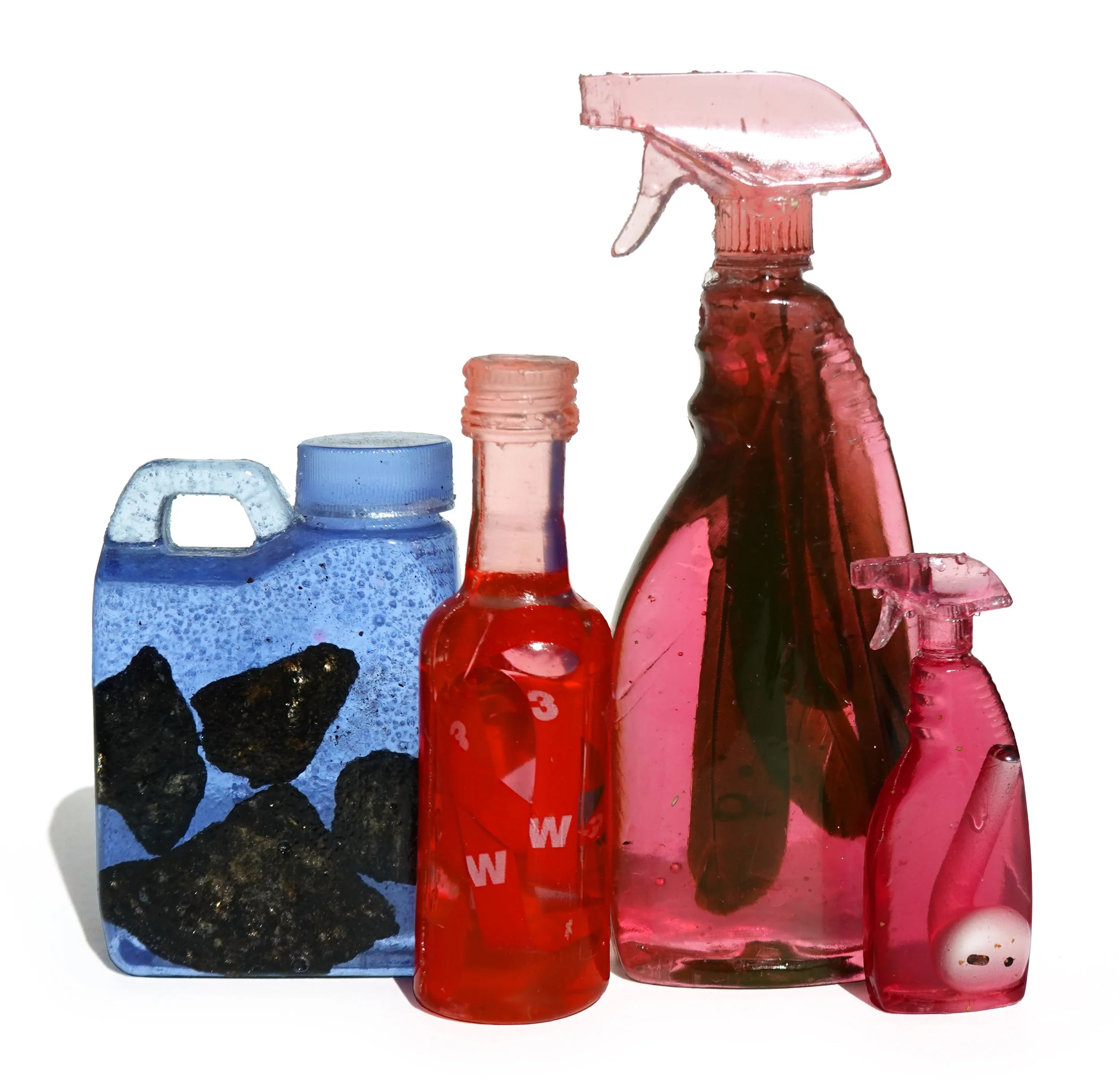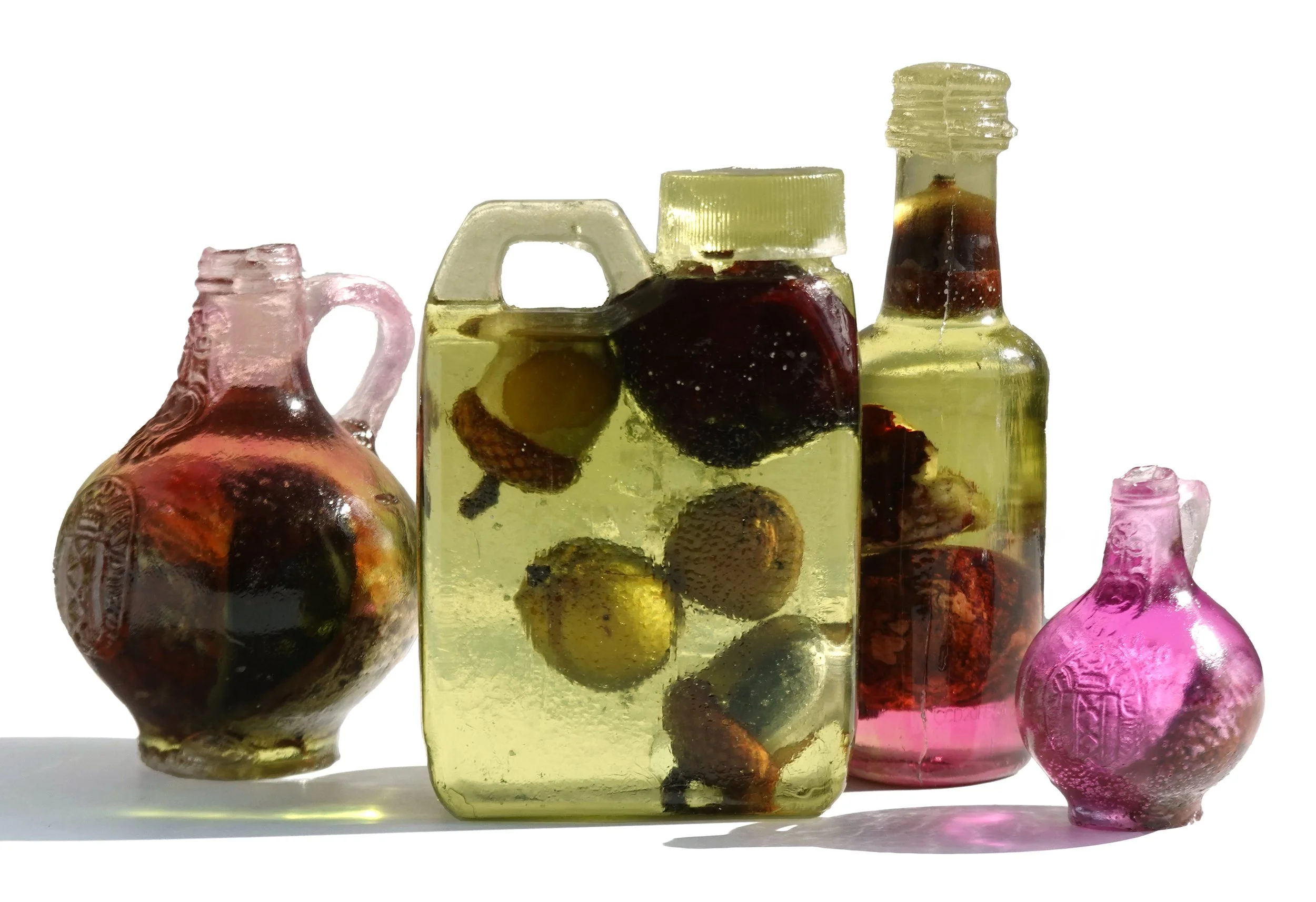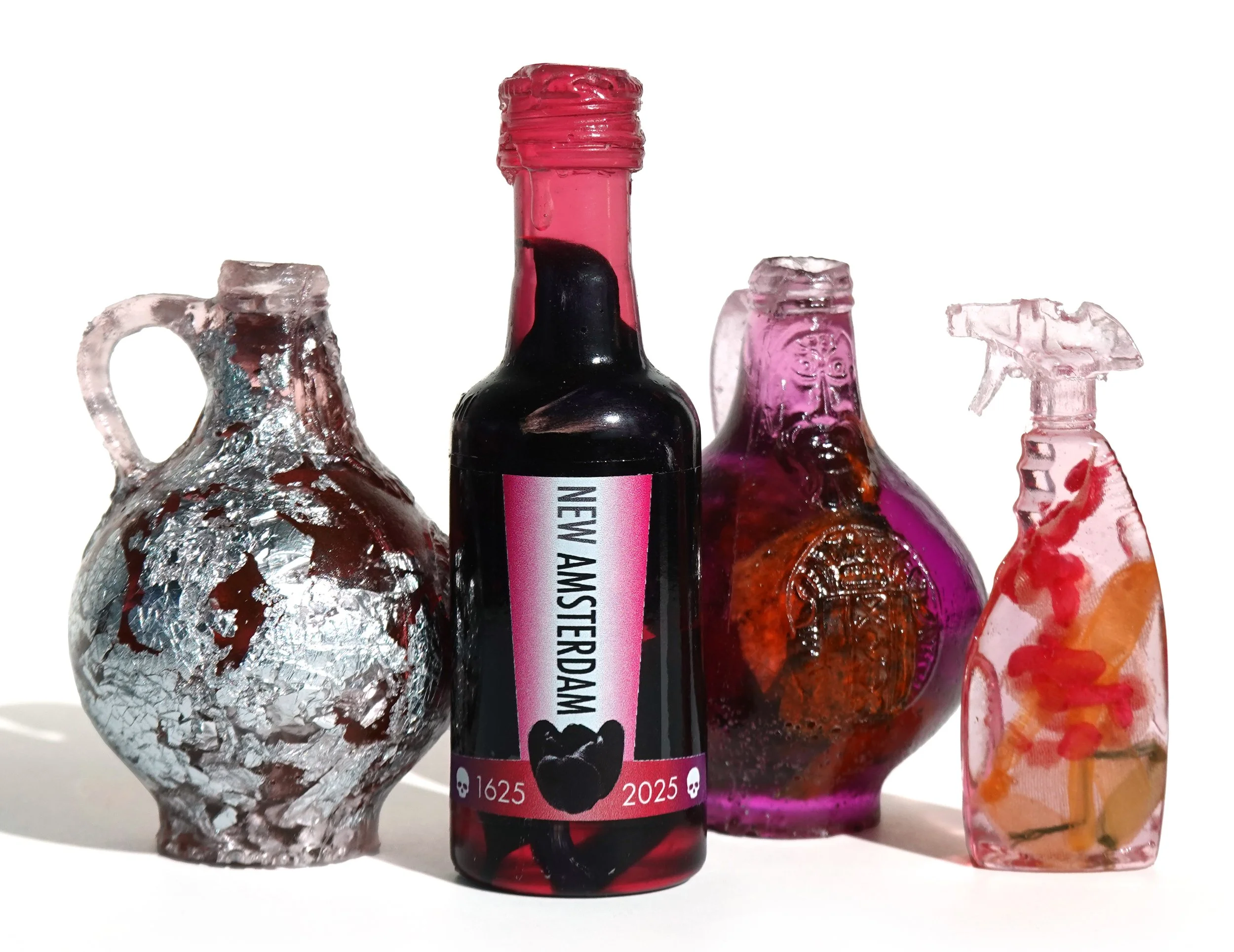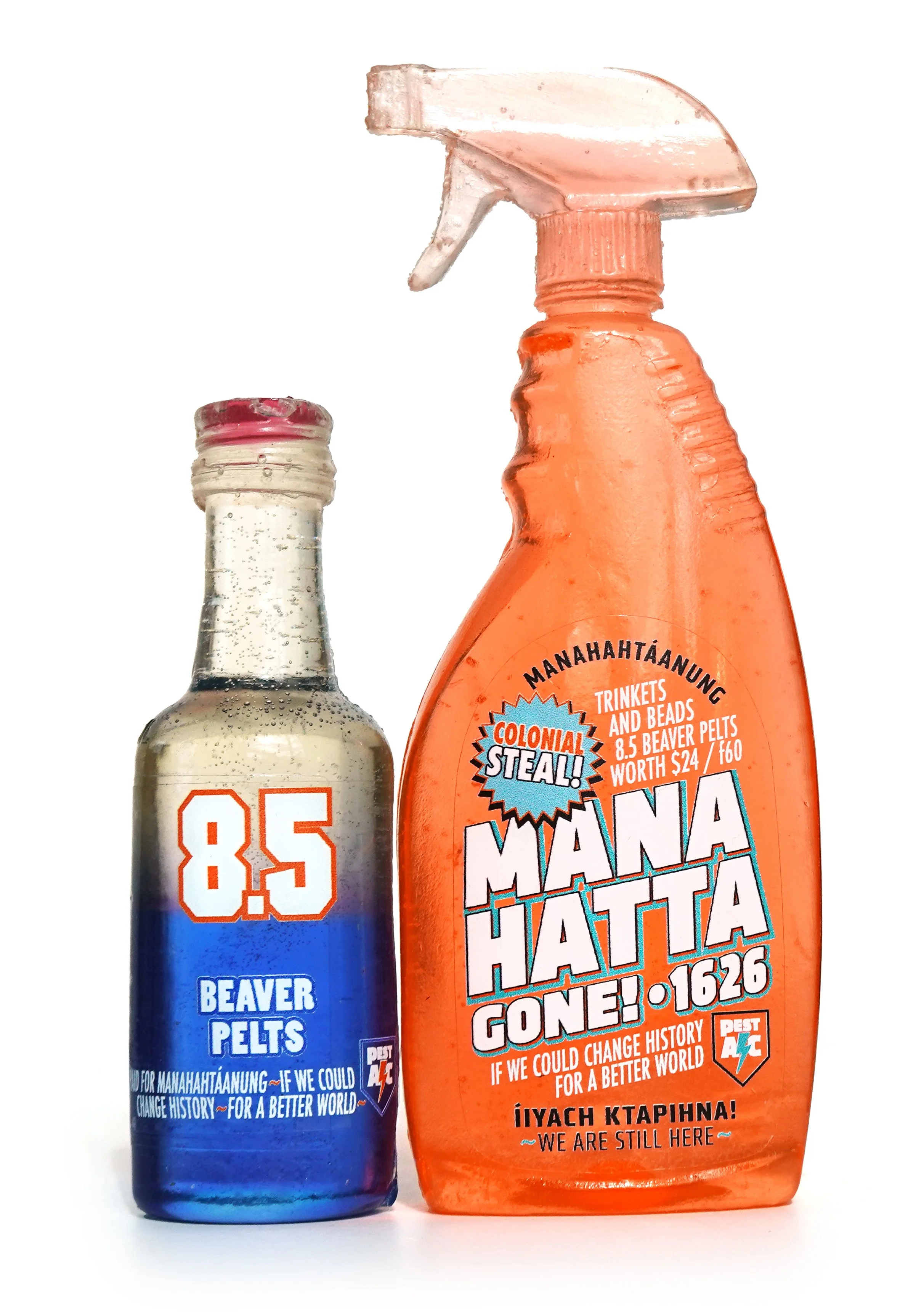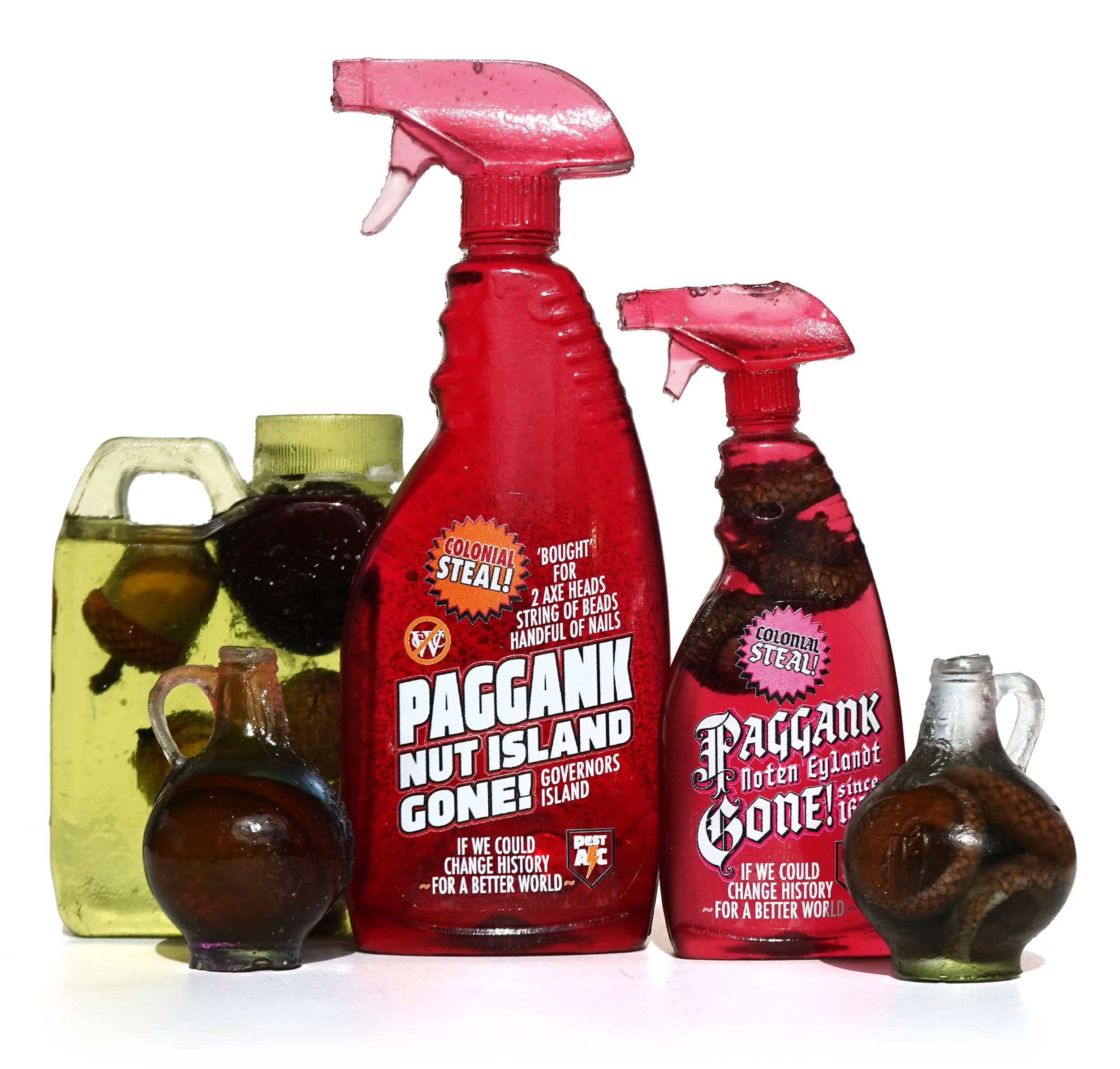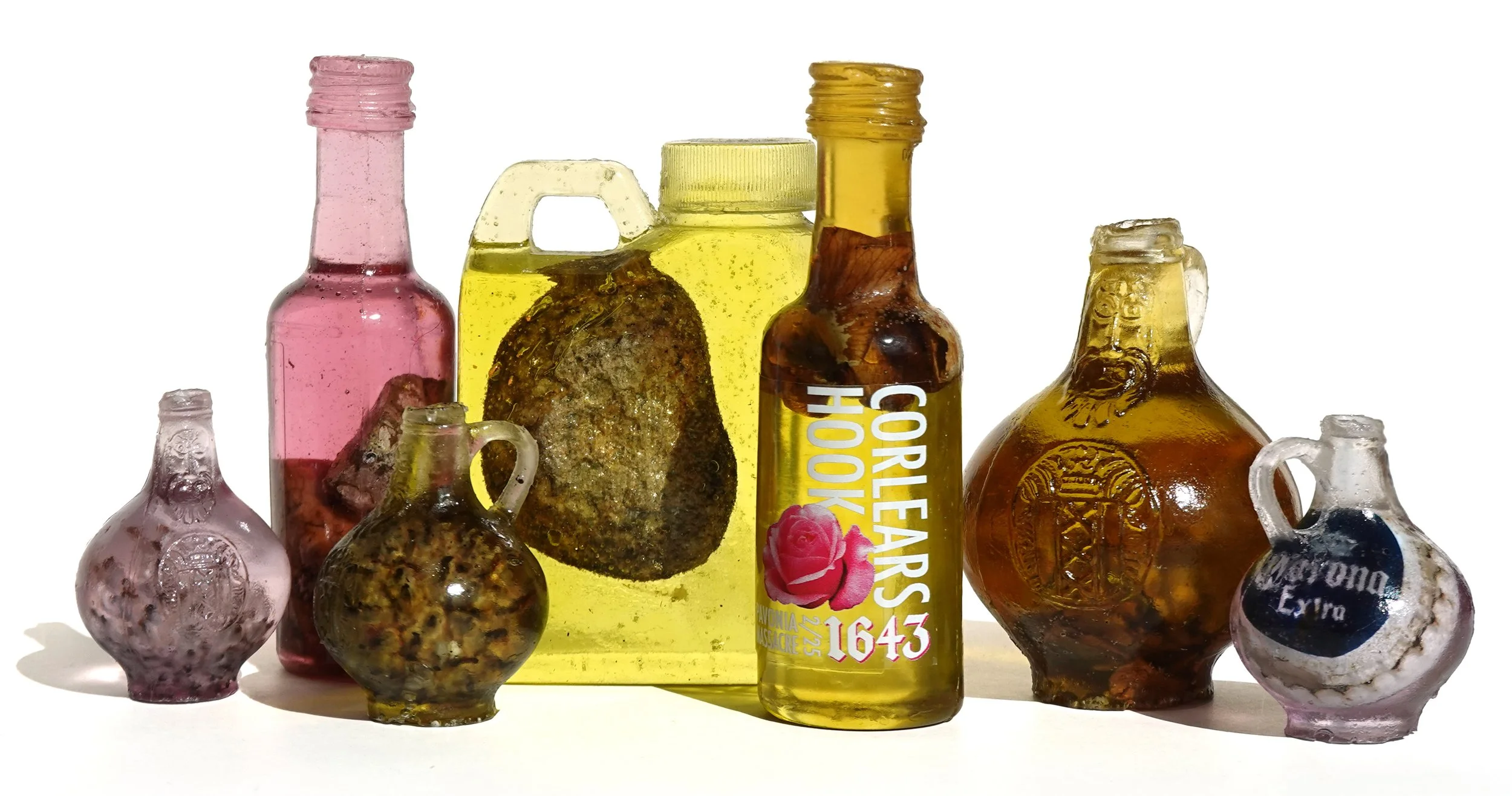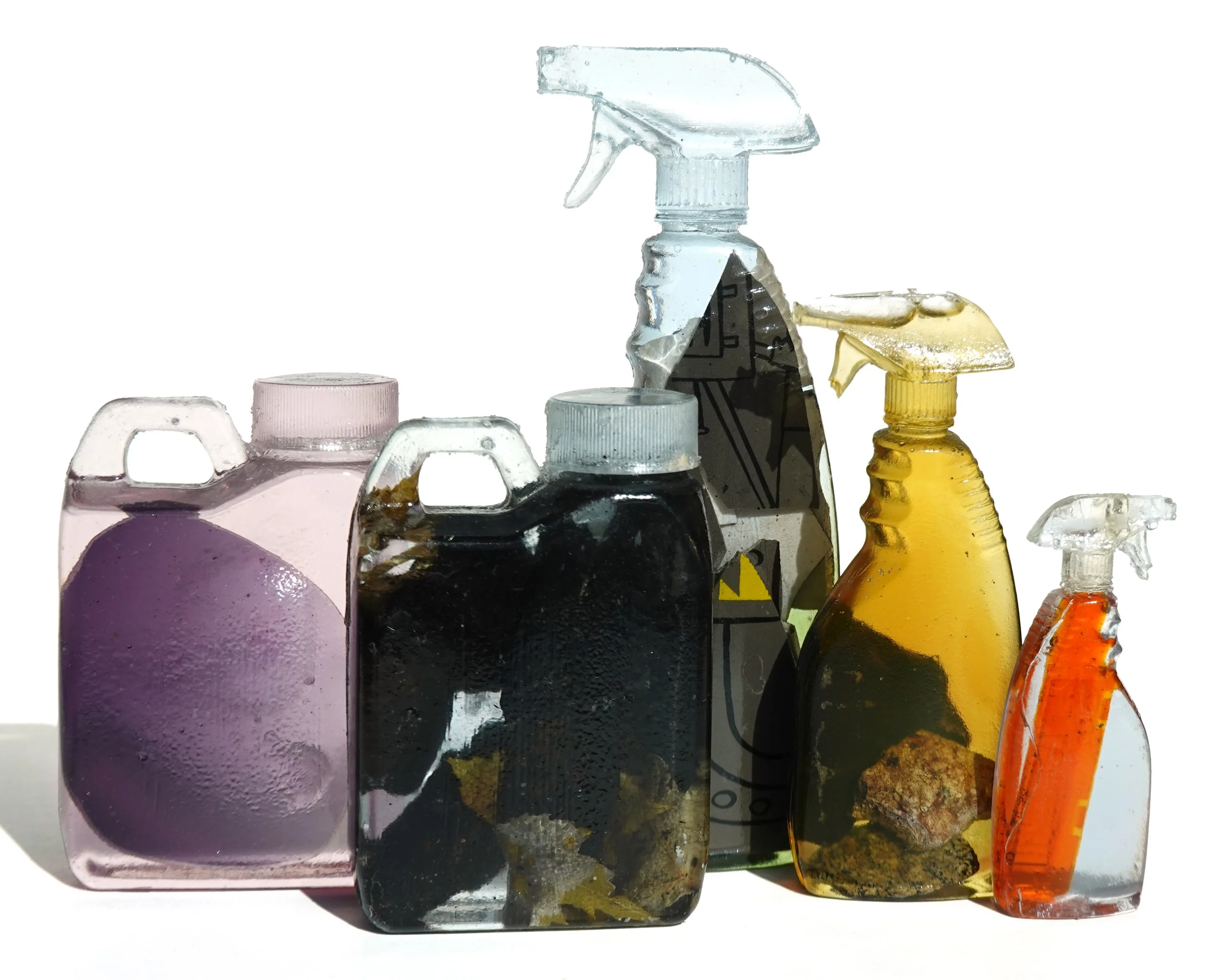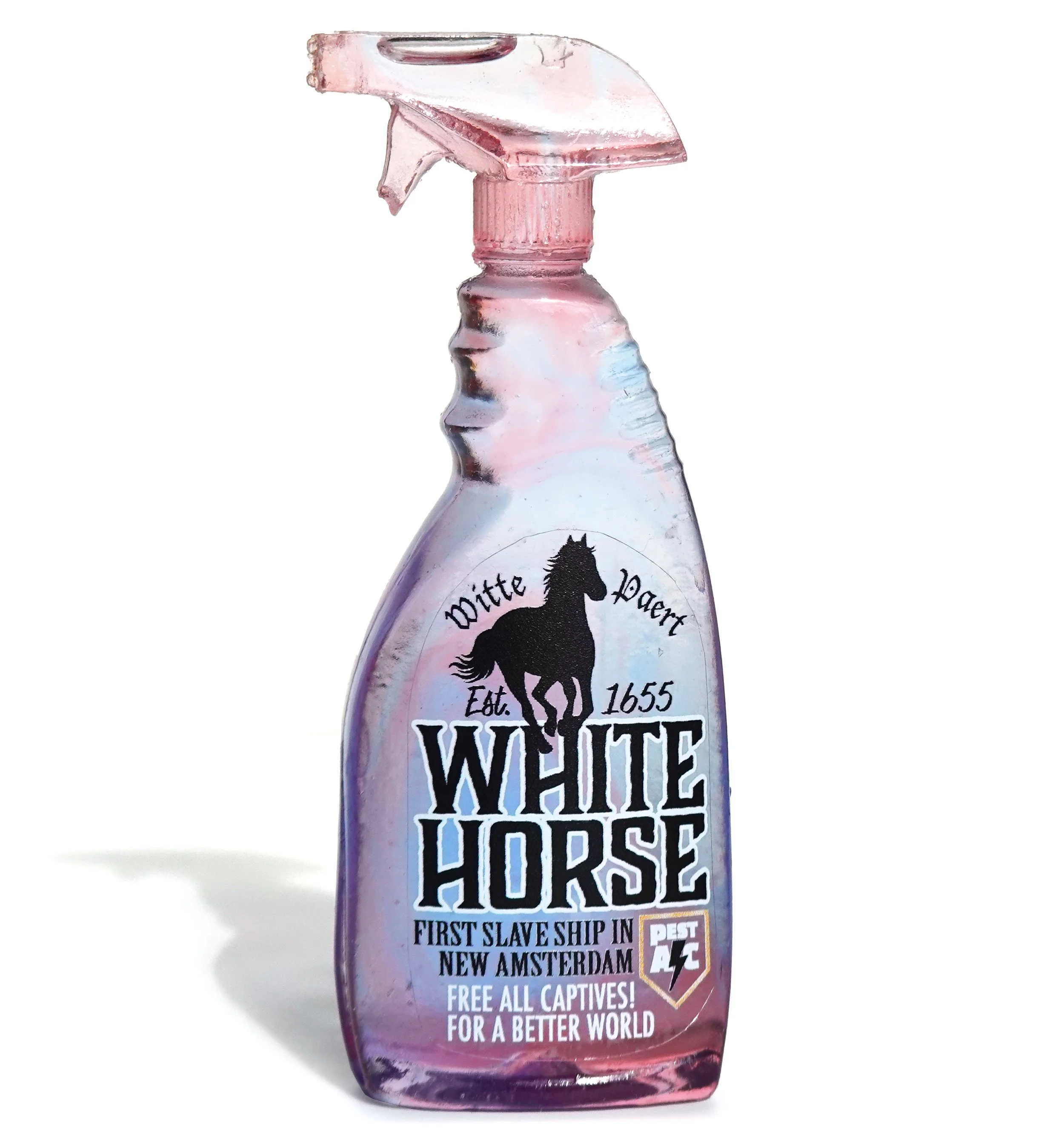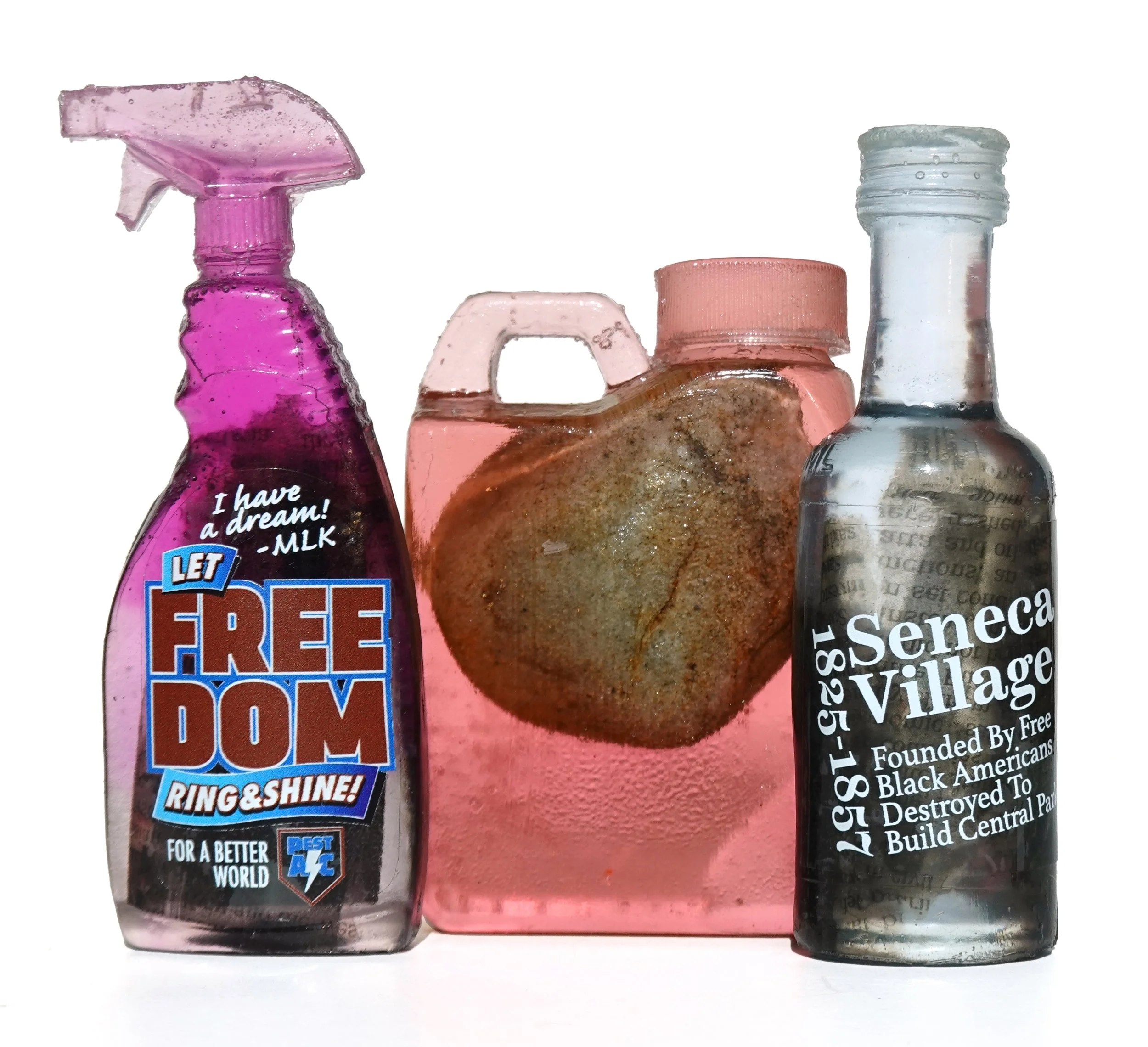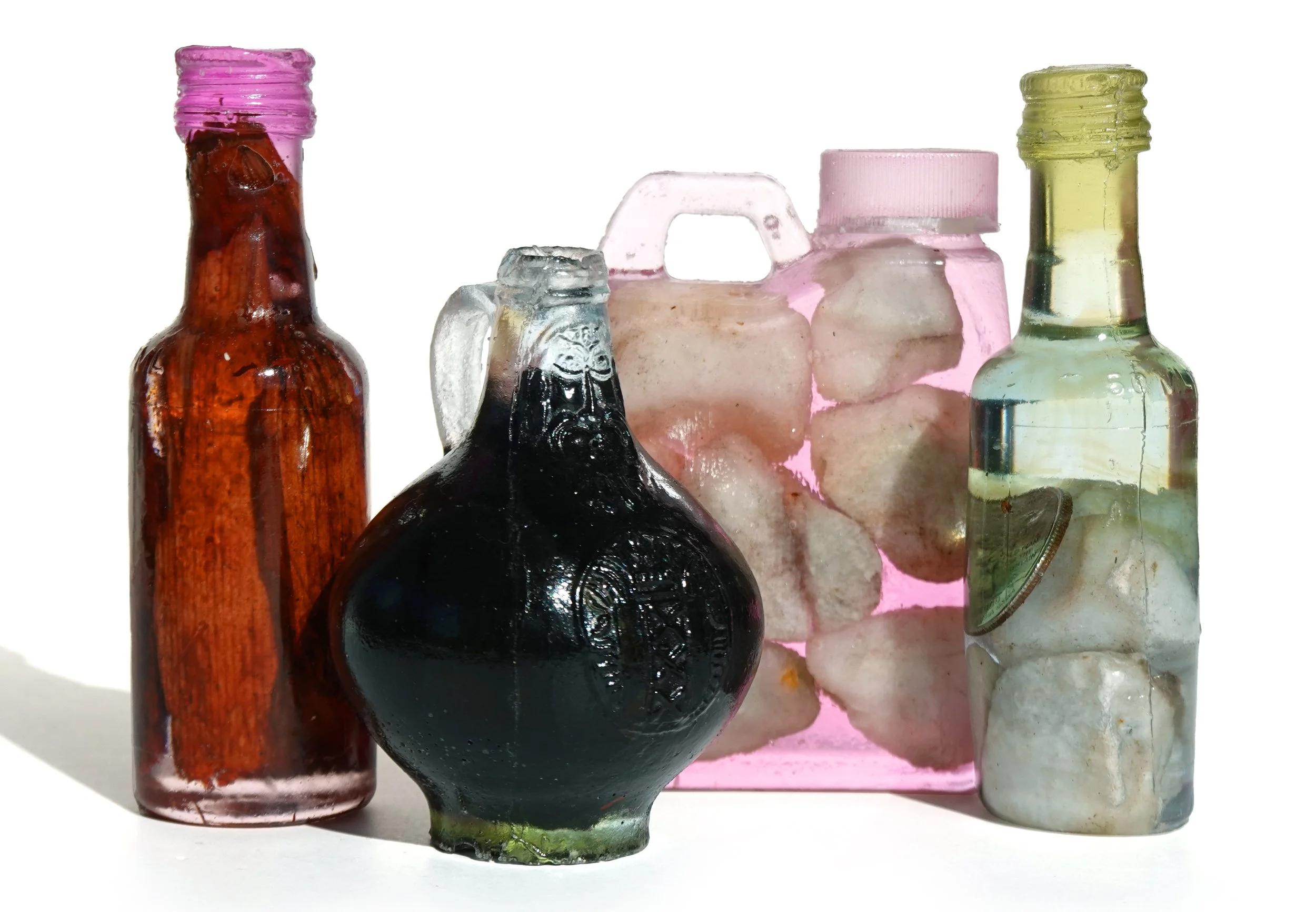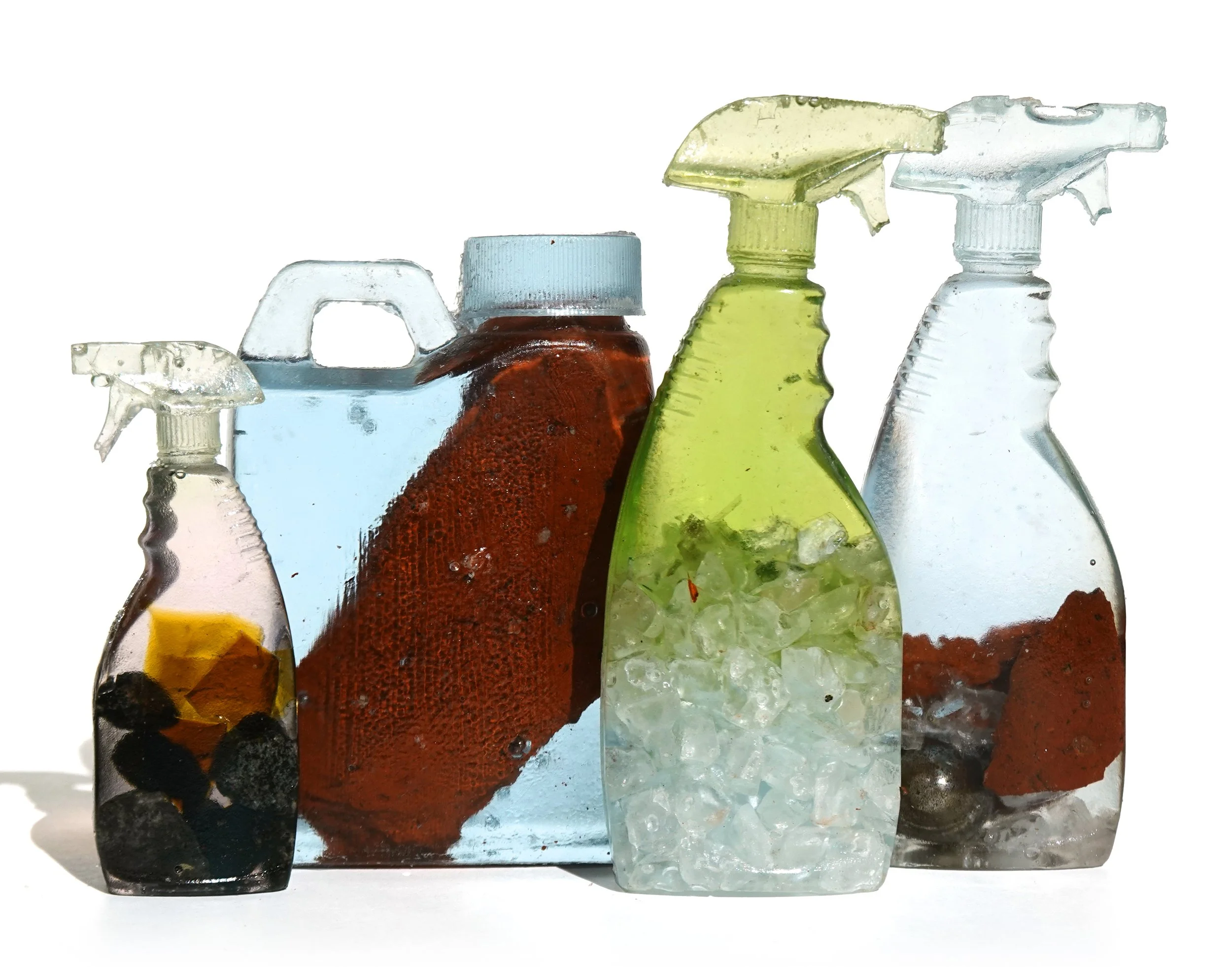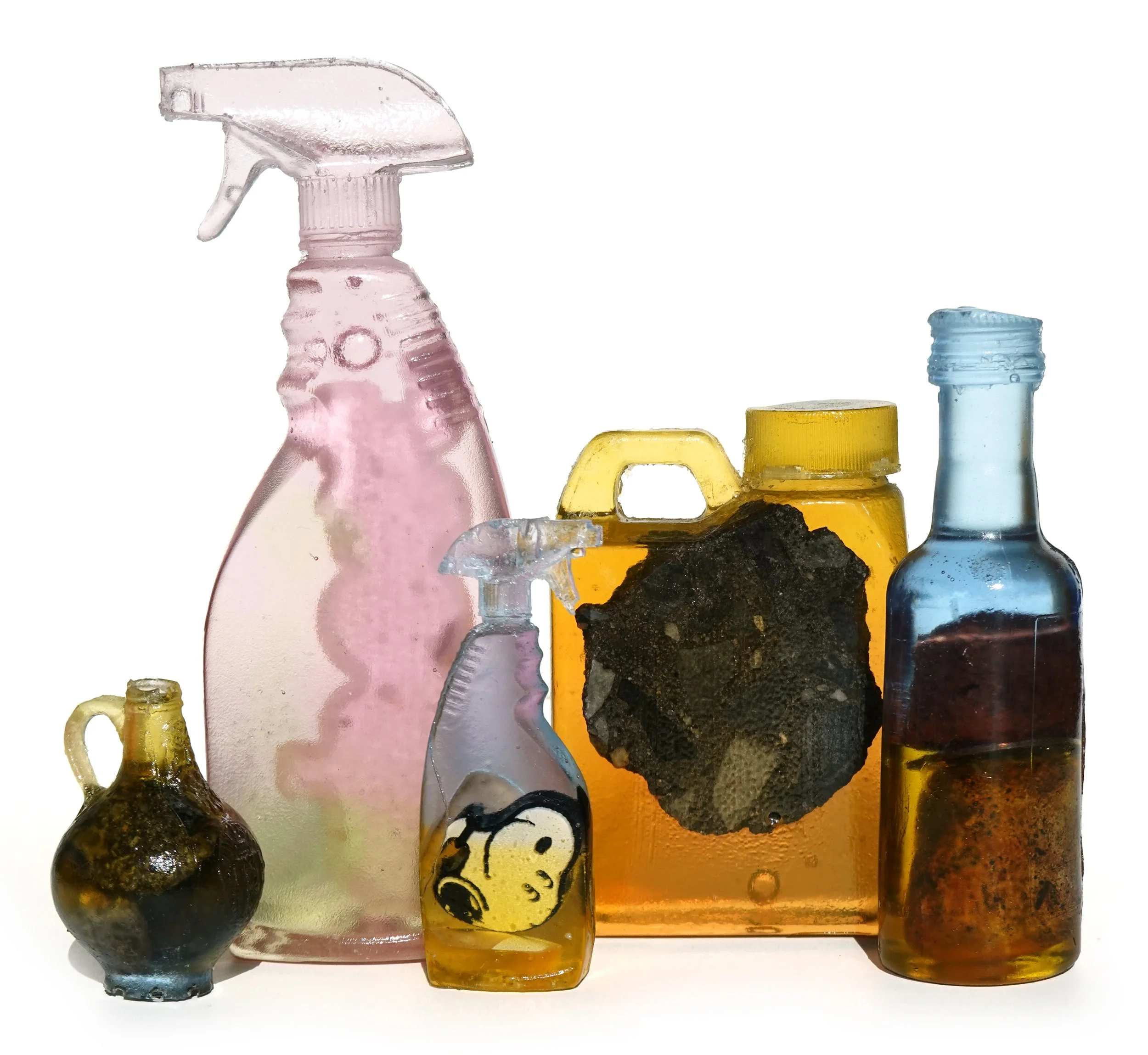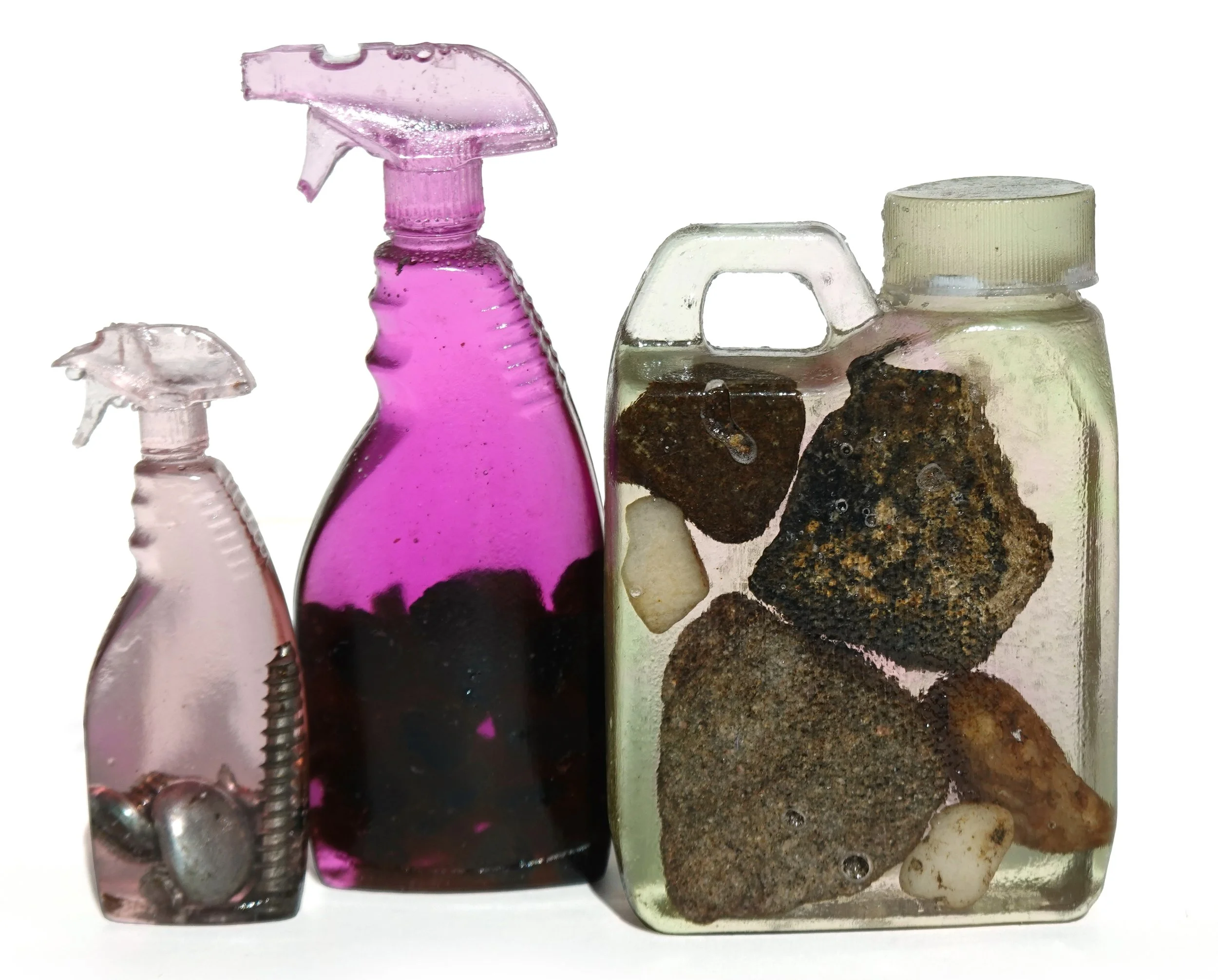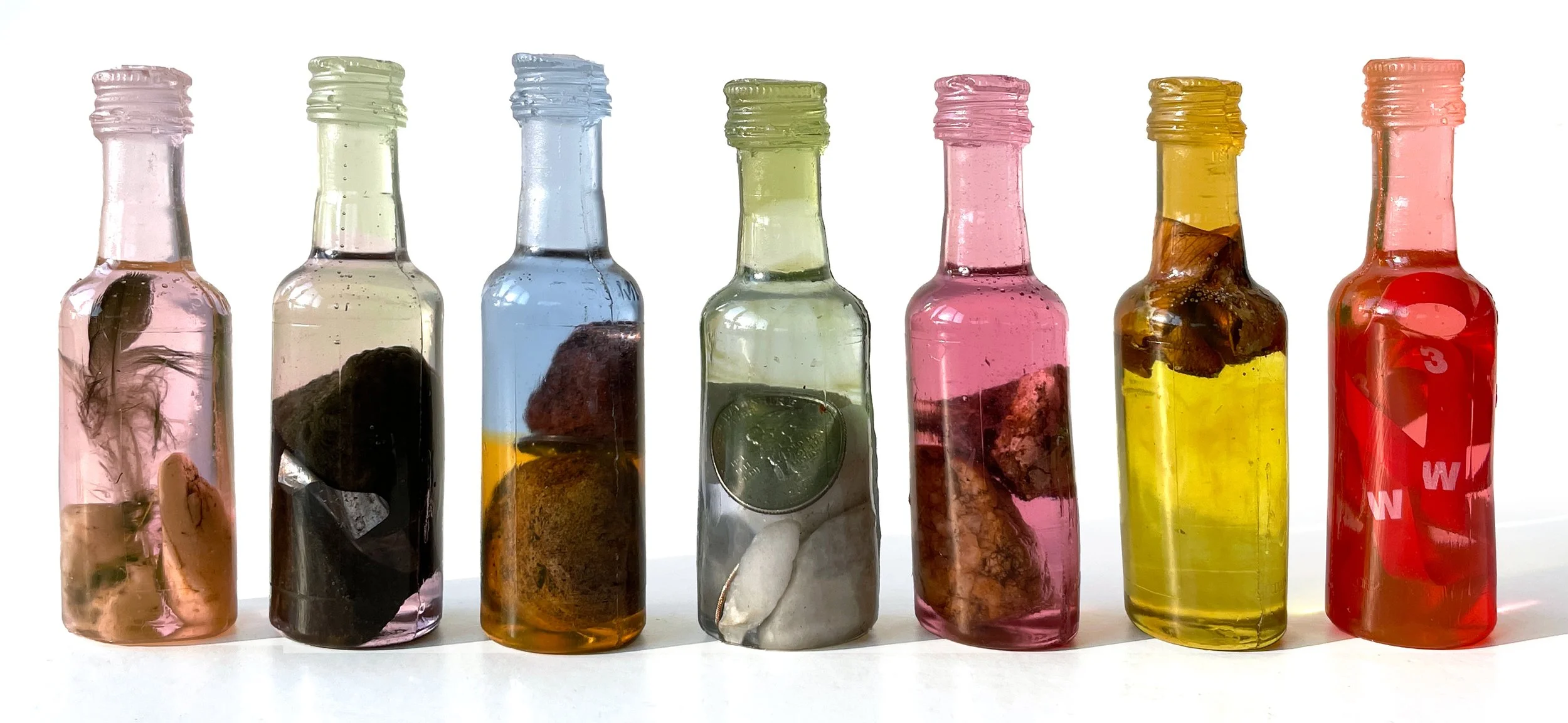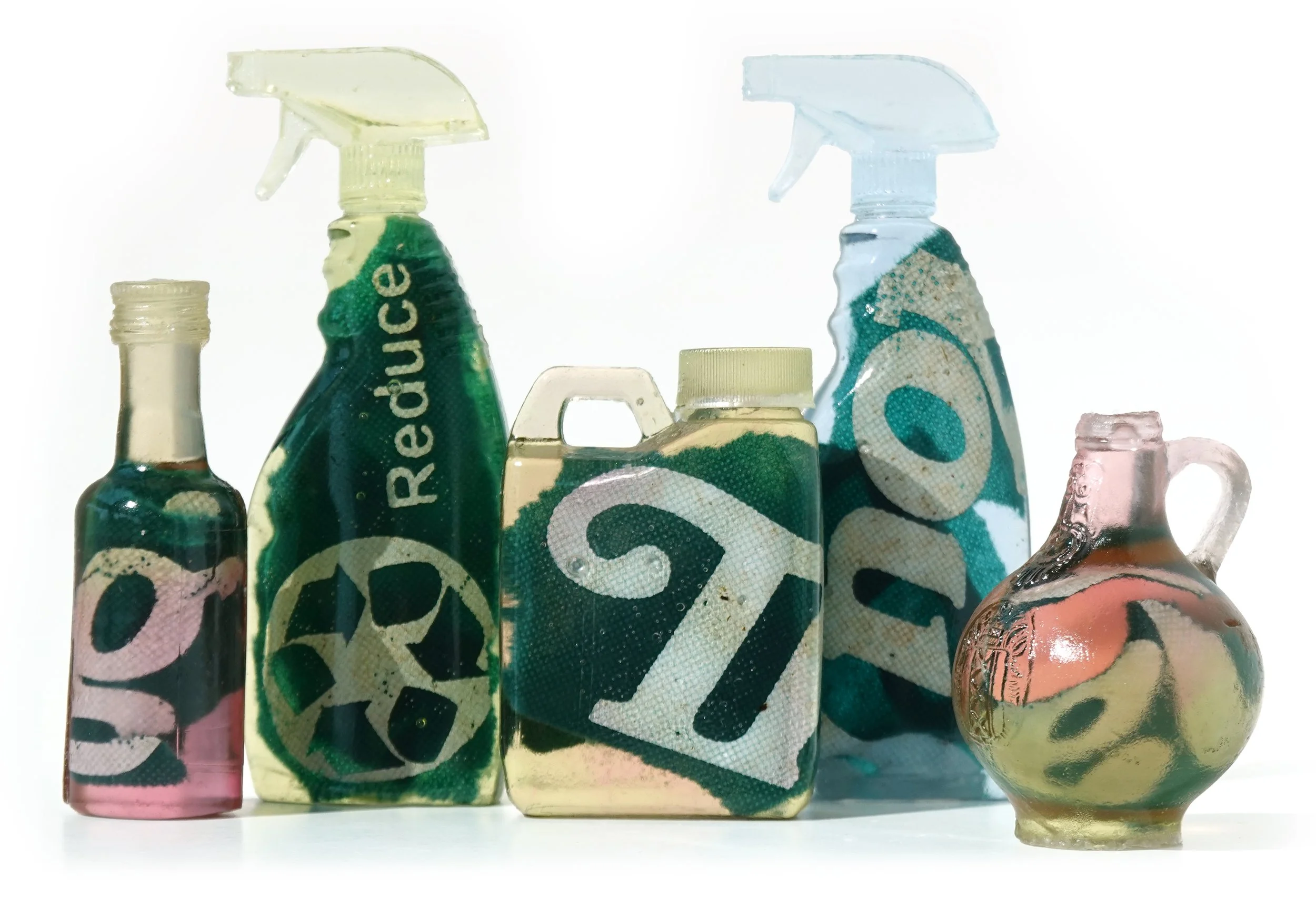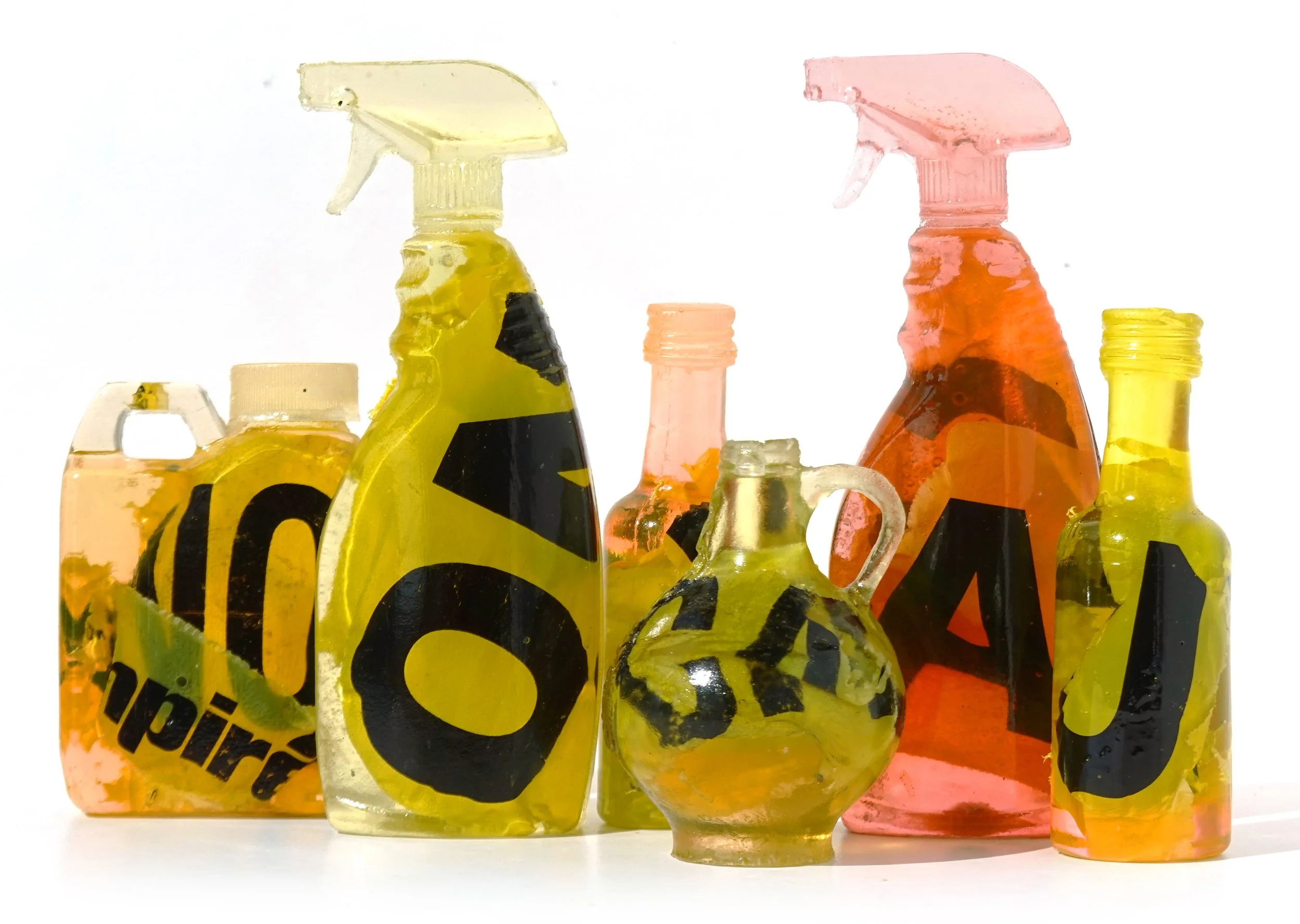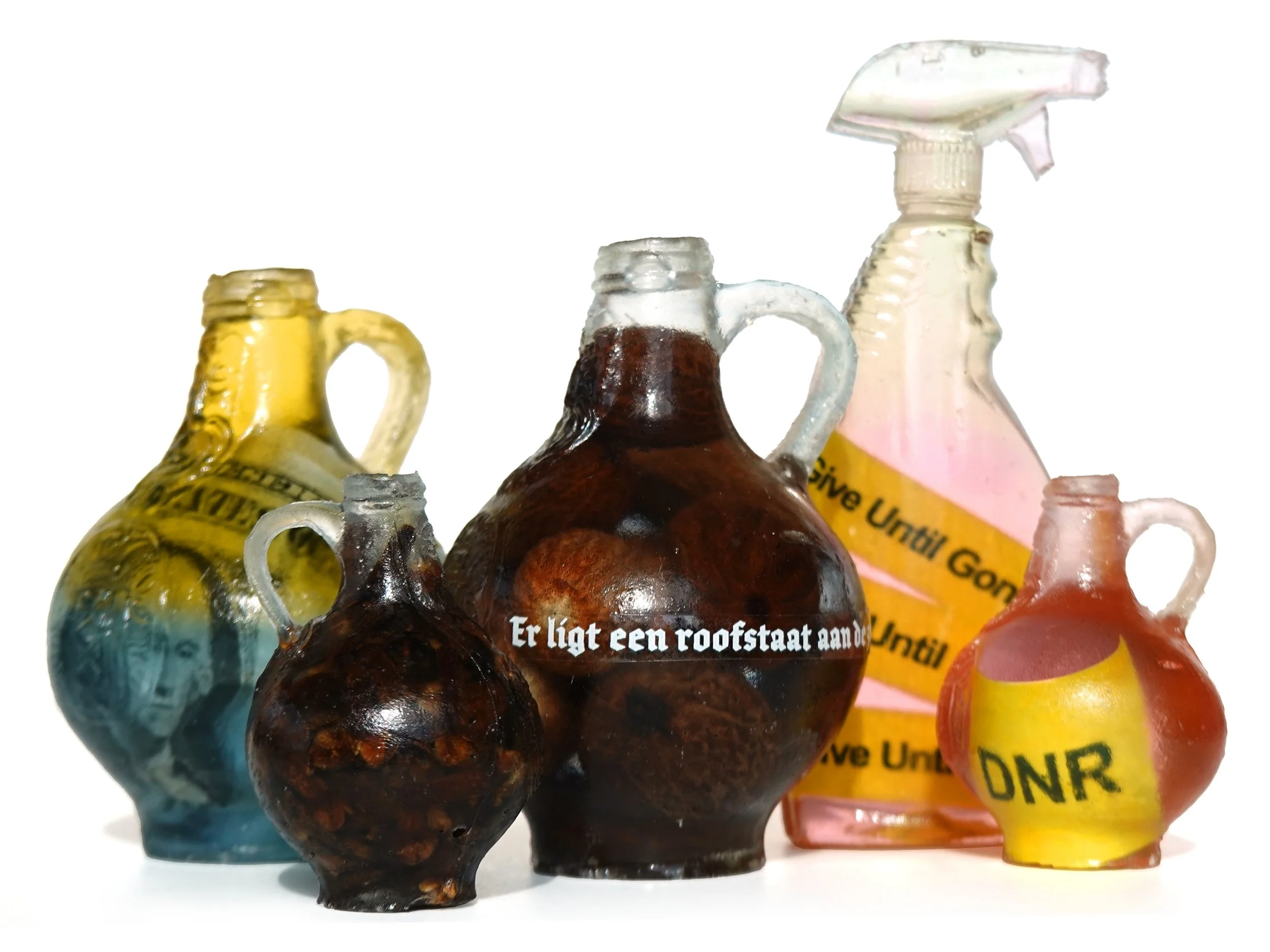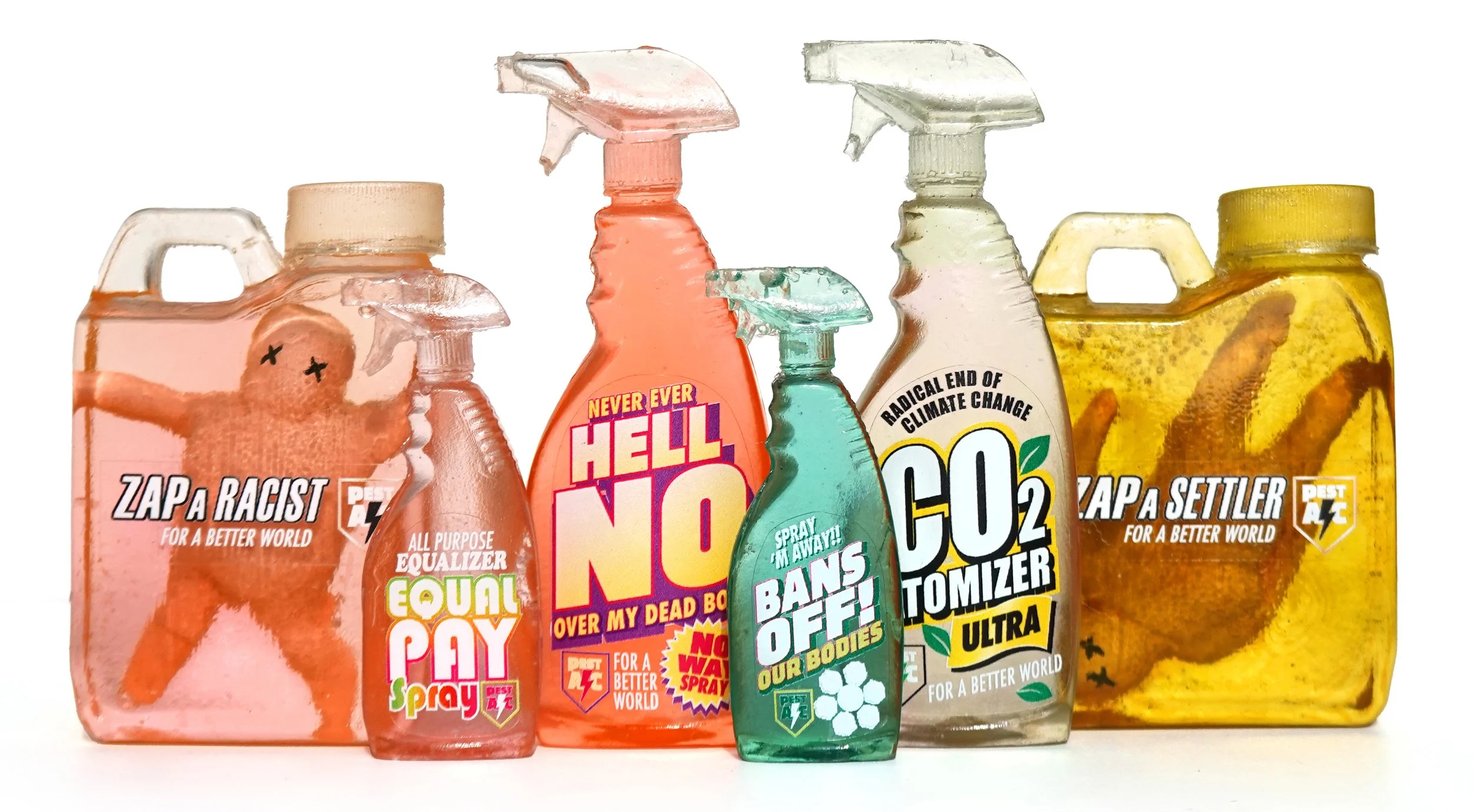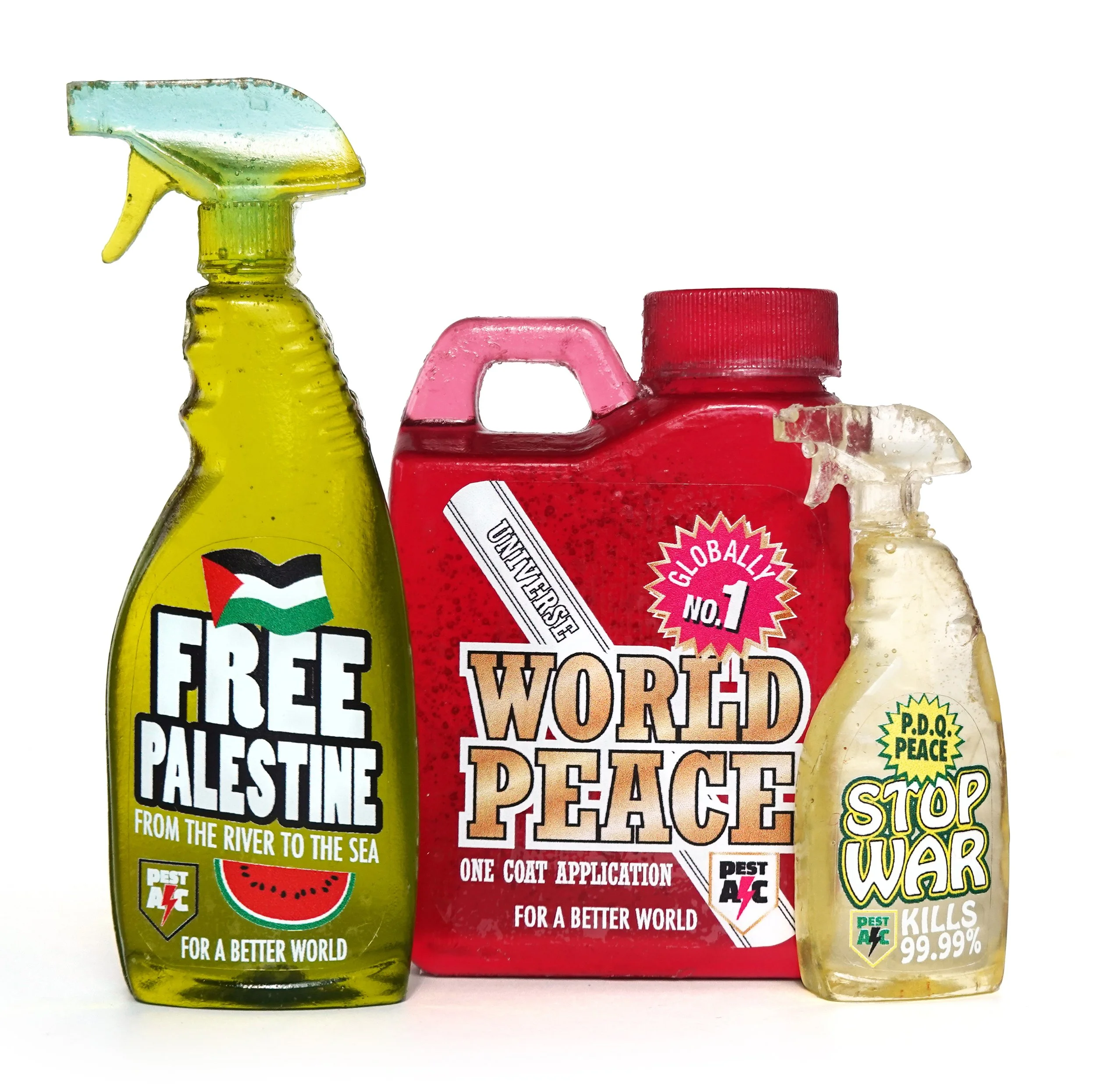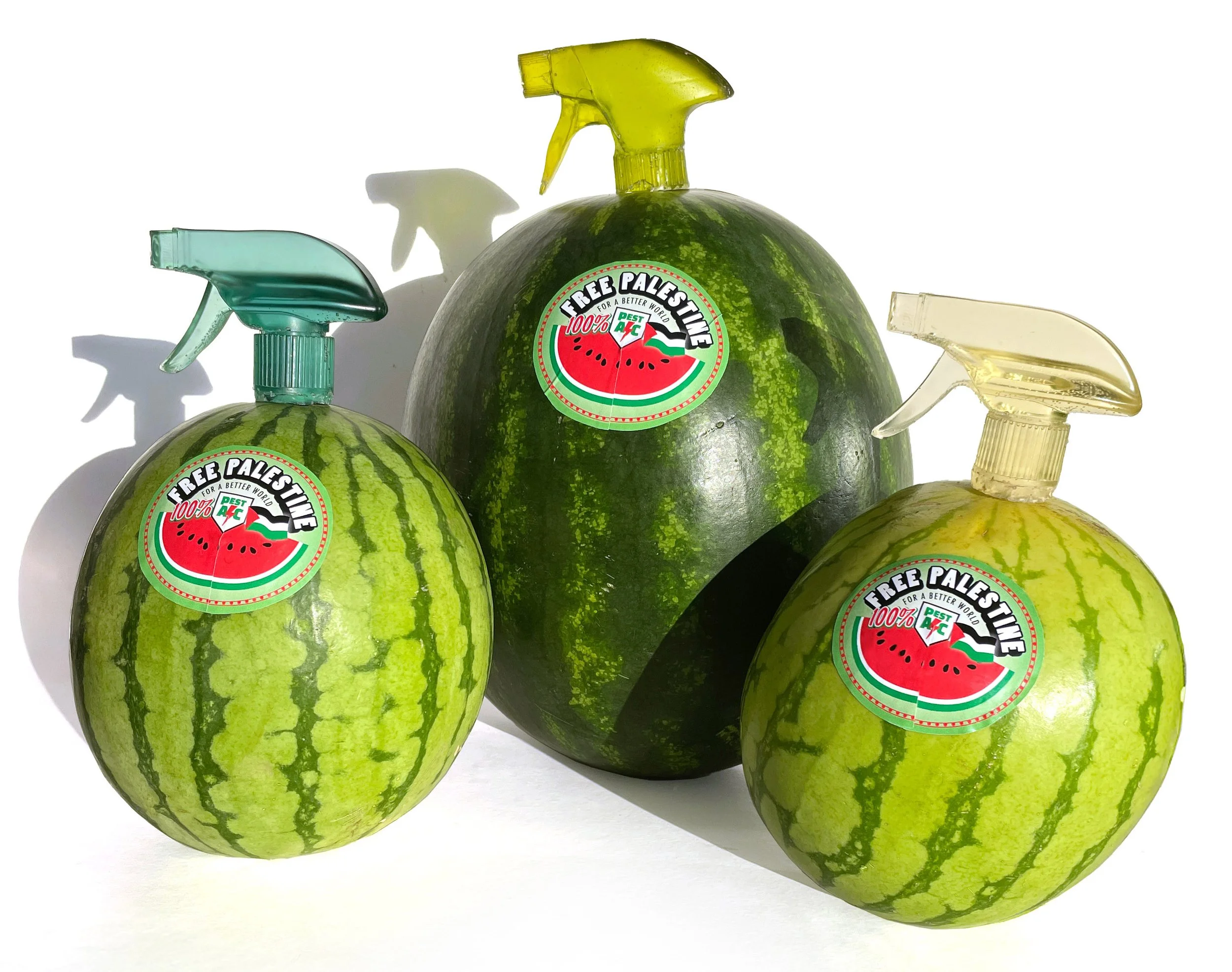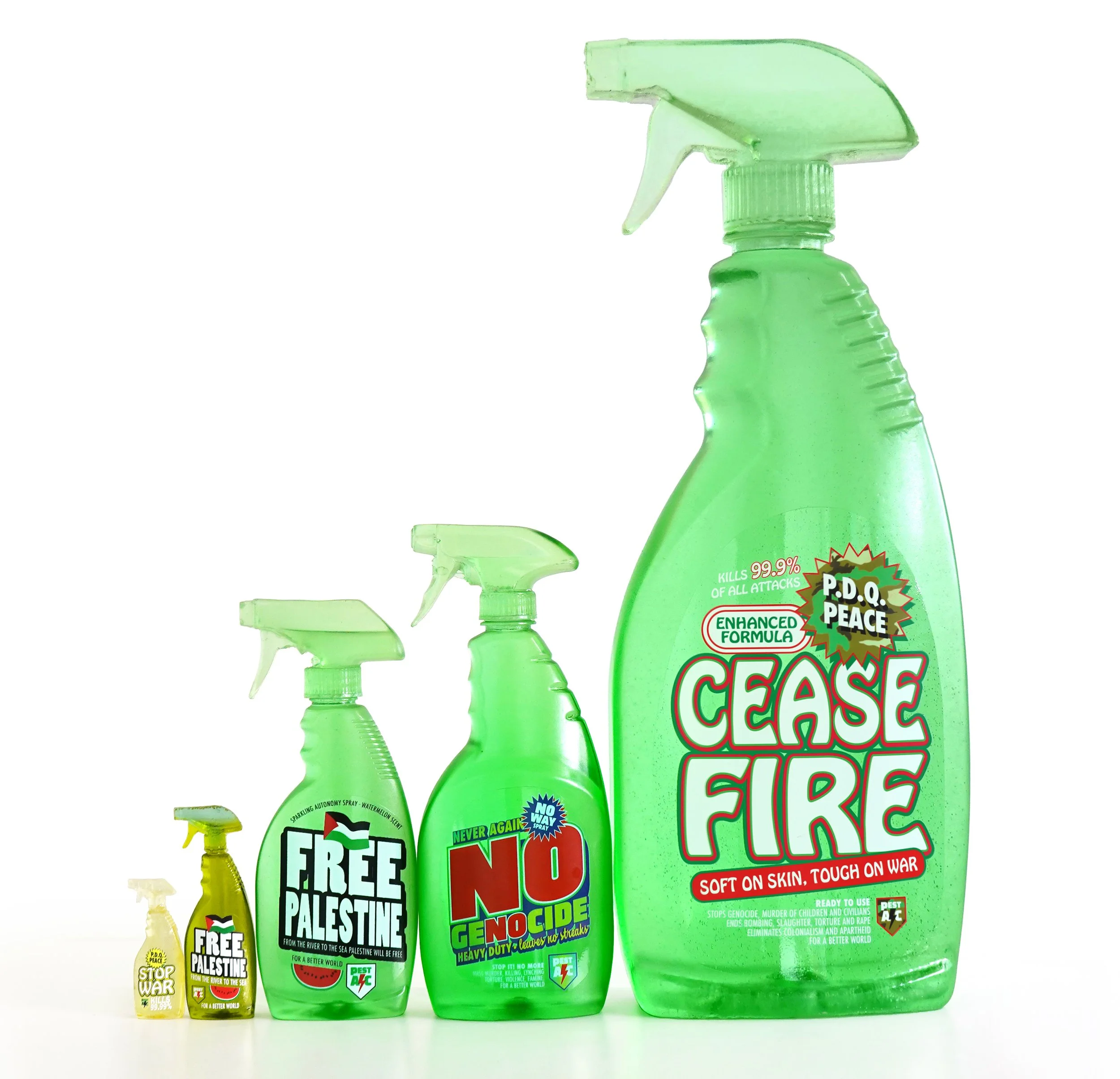GOVERNORS ISLAND
During my artist residency at ArtCrawl Harlem on Governors Island, NYC, I learned to create molds and cast objects in resin. I researched the colonial history of New Amsterdam that started on Governors Island, with the first Dutch settlers - who actually were Walloons from Belgium. From the 17th century, enslaved Africans built the city, and the indigenous Lenape were murdered or expelled. Found objects, collected at historical locations, were included in the resin objects to remember and honor the people and the stories we don’t learn about in school.
Installation view at Governors Island, 2025
6950 B.C. LENAPE
Lenapehoking. New York Harbor was once home to 220,000 acres of oyster reefs. The Lenape ate oysters, leaving the shells on the banks in piles, shell middens. The oldest, in Dobbs Ferry, dates to 6950 B.C. Pearl Street is named for a midden, and a large one existed where Canal Street and the Bowery intersect. The Dutch in New Amsterdam continued the oystering tradition of the Lenape, and called Ellis Island ‘Oyster Island’ and Liberty Island ‘Great Oyster Island.’ Today, the Billion Oyster Project aims to bring back the oysters.
Oyster shells, air pearls, resin, 3-4”/7,5-10cm, 2025
1492 COLUMBUS
Christopher Columbus landed on the island Guanahani (San Salvador) in the Bahamas on October 12, 1492, looking for a western sea passage to the East Indies. Columbus never even set foot on Turtle Island (North America), yet he gets a holiday. Let’s celebrate Indigenous Peoples’ Day instead.
Solid cast resin, labels, 4.5-6”/11-15cm, 2025
1794-1811 GOVERNORS ISLAND
Castle Williams was designed and erected between 1807 and 1811 under the direction of Colonel Jonathan Williams. The earthen Fort Jay (1794) was rebuilt from 1806-1809. This new fort was named Fort Columbus from 1806 to 1904, before reverting to the name Fort Jay in 1904, after John Jay, a Founding Father.
Fort Jay slate, Williams Castle stones, resin, 3-6”/7-15cm, 2025
1588-1672 FAKE GOLD
The 17th century was the so-called Dutch ‘Golden Age.’ The Dutch East India Company (VOC) and the Dutch West India Company (WIC) became global powers through advanced shipbuilding techniques and the ruthless use of violence. The Dutch elite grew filthy rich from colonialism, looting, oppression, exploitation, rape, and murder across the world. Even today, they still call this ‘trade.’
Fake gold leaf cast in resin, labels, 3-6”/7-15cm, 2025
1609 HUDSON
When Henry Hudson sailed back on the Half Moon along the Mahicannituk - the river that flows both ways (the Hudson River) - after failing to find a water route to Asia, two Lenape came aboard. Hudson dressed them in red jackets and tried to keep them captive to take them to the Netherlands. But they jumped overboard, and a dozen Lenape came to their rescue in canoes. Hudson’s crew shot and killed them all near what is now West 140th Street in Harlem, NYC.
Stones, ribbon, feathers of an American robin, and an earpod, cast in resin, 2-6”/5-15cm, 2025
1624 PAGGANK
Dutch colonists - Walloon families - settled on Paggank (Governors Island), and called it Nooten Eylandt, Nutten Island, because of the abundance of nut trees like hickory, chestnut, and oak. They built a wind-powered sawmill and left the island after a year to settle on Manahahtáanung because there was not enough fresh water on the small island.
Acorn, chestnut, and hickory nuts, cast in resin, 2-4”/4-10cm, 2025
1625 NEW AMSTERDAM
New Amsterdam (at Bowling Green) was founded by the Dutch when they colonized Manahahtáanung. The population was estimated at around 270 people, including European colonists and enslaved Africans who built Fort Amsterdam and the wall at what is now called Wall Street.
Black tulip leaves, wood chips, silver leaf and embroidery, resin, 3”-4”/7-10cm
1626 MANAHAHTÁANUNG
Manahahtáanung/Manahatta was ‘bought’ by Peter Minuit, on May 24, 1626, in Inwood Hill Park, for $24 /ƒ60. The third Governor of New Netherland closed the deal with Canarsie chief Seyseys, who was happy to accept valuable merchandise in exchange for an island that was actually mostly controlled by the Weckquaesgeeks.
1637 VAN TWILLER
Paggank, Nooten Eylandt (Governors Island) was ‘purchased’ by Wouter van Twiller, fifth Director of New Netherland, aka Walter the Doubter, aka the beer barrel on skids, on June 16, 1637, for his own use. He paid two axe heads, a string of beads, and a handful of nails. He also bought Ward’s and Randall’s Island.
Nuts from Governors Island, cast in resin, labels, 2-6”/5-15cm, 2025
Pavonia Massacre, also known as The Slaughter of the Innocents. 120 Lenape, including women, children and babies were killed by Willem Kieft, sixth Director of New Netherland, on February 25, 1643. The settlements in Pavonia (Communipaw, NJ) and Corlears Hook (Lower Manhattan) were wiped away. Read the gruesome eye-witness report here.
Corlears Hook Park: gumtree, stones, rose and beer caps, cast in resin, 2-4”/4-10cm, 2025
1643 PAVONIA MASSACRE
The Pavonia settlement location is now a parking lot in Communipaw, NJ.
Sunglass, stones, porcelain shards, reflector, cast in resin, 3-7”/6-15cm, 2025
1655 WHITE HORSE
The first direct shipment of enslaved Africans arrived in New Amsterdam in 1655. The slave ship White Horse, ‘Witte Paert’, carried 300 captured Africans in miserable conditions. Many Africans didn’t survive the long voyage. In the 1660s, 30% of the population of New Amsterdam were enslaved Africans.
1825 SENECA VILLAGE
Seneca Village at West 86th Street was founded in 1825. The settlement of mostly free African American landowners existed until 1857, when the villagers were forced to leave and their houses were torn down for the construction of Central Park.
Stone, pieces of New York Times, 3.5-4.5”/8-11cm, 2025
AFRICAN BURIAL GROUNDS
During my artist residency, I read about many African Burial Grounds. The largest and most well-known is the African Burial Ground National Monument in Lower Manhattan, but there are many more. The white colonists didn’t allow enslaved Africans to be buried at the church’s graveyard. The African burial grounds were forgotten or desecrated, while the graveyards of the colonists were taken care of and still exist today.
The African Burial Ground site at Duane Street and African Burial Ground Way (Elk Street) is New York’s earliest known African-American cemetery. The Burial Ground dates from the mid-1630s to 1795. An estimated 15,000 people were buried here. The site contains the remains of more than 419 Africans buried during the late 17th and 18th centuries in the largest colonial-era cemetery for people of African descent, some free, most enslaved. The African Burial Ground National Monument, designed by Rodney Leon, a Haitian-American architect, was opened in 2007.
Stones, wood, rubber, and a quarter, resin, 3-4”/7,5-10cm, 2025
1635
The Harlem African Burial Ground at 126th Street and 2nd Ave is at MTA’s decommissioned Bus Depot, to be developed into a memorial and mixed-use project. It was a segregated cemetery created in 1668 for the burial of enslaved and freed Africans in the Dutch colony of ‘Nieuw Haarlem’. The burial ground was maintained until 1858 by the Elmendorf Reformed Church, the successor of the Low Dutch Reformed Church of Harlem, which founded the cemetery. ‘Nieuw Haarlem’ was founded in East Harlem at 121st Street in 1658 by Peter Stuyvesant, the seventh and final Director-General of New Netherland, before the English took control of the colony in 1664 and named it New York.
Stones, brick, glass grit, screws, resin, 3.5-4.5”/7-11cm, 2025
1668
The Flatbush African Burial Ground or FABG on 2286 Church Avenue, Brooklyn, was in use from the 17th century, with some evidence suggesting burials began as early as the late 1690s, through the abolition of slavery in New York in 1827. It was just east of the main village that centered around the Flatbush Reformed Dutch Church, and its graveyard, still there one block to the west on Flatbush and Church avenues.
Stones, quarter, Snoopy pin, resin, 2-6”/5-15cm, 2025
1697
Enslaved African & Kingsbridge Burial Grounds in Van Cortlandt Park, The Bronx. Van Cortlandt had 20 enslaved Africans on the plantation. For approximately 200 years, the Van Cortlandt family plantation relied upon the labor of enslaved people. They built the pond, the mill, and the house. Also, some indigenous people were enslaved. The enslaved people on the Van Cortlandt estate were freed in 1821.
Park sign, stones, sidewalk chalk, confetti, leaves, white snakeroot, resin, 3.5-6”/7-15cm, 2025
1698
Inwood African Burial Ground. The Dyckmans and other Uptown families made use of enslaved labor to build their farmhouses. In 1903, the burial ground was discovered. Reports said that ‘huge skeletons’ with ‘iron balls and chains hanging from their limbs’, had been found. The burial ground was desecrated, looted, and demolished. On Tenth Avenue and West 212th Street is now a homeless shelter and a memorial for the thirty buried Africans and the Lenape ceremonial pits that were found in the same location.
Screws, solder, asphalt grit, stones, resin, 3.5-4.5”/7-11cm, 2025, 2025
1784
(work in progress; more African Burial Grounds can be found in Queens, Hunts Point, and Staten Island.
TODAY
If you don’t know where you’ve come from, you don’t know where you’re going. - Maya Angelou
Colonialism and oppression still exist. Even the most ‘developed’ countries with the ‘highest morals’ are guilty of settler colonialism, racism, apartheid, authoritarianism, LGBTQIA2S+ hate, misogyny, and genocide.
Where do we go from here? Chaos or community? - Dr. Martin Luther King Jr.
Thank You, for ruining the planet. I found an eco-friendly reusable tote bag that was shredded by the mower machine on Governors Island. A bitter-sweet metaphor for the unstoppable climate change. If We Could Change History…
Scraps, resin, 3-6”/8-15cm, 2025
2025
Caution. No Empire. Leftover and forgotten pieces of caution tape are everywhere. Save democracy!
Caution tape, resin, 3-6”/8-15cm, 2025
2025
Capitalism. From The Nutmeg’s Curse (by Amitav Ghosh, reading tip) to Bitcoin: it’s all about money. Billionaires get richer, oligarchs and dictators suck up all the money in the world. Greed is god, corruption is mainstream, and the land of the free becomes a dictatorship.
Dollar bill, cloves, nutmeg nuts, stickers, resin, 2-4.5”/5-11cm, 2025
1500s-NOW
Pest AC. For A Better World. Resist, fight for equal pay, reproductive freedom, and the climate. End racism, colonialism, apartheid, hate.
Paperclay racists cast in resin, labels, resin, 3-4.5”/7,5-11cm, 2025
HELL NO
Free Palestine, World Peace, Stop War. Make love, not war.
Resin, labels, 3-4.5”/7,5-11cm, 2025
Danger / Peligro. Remains of danger tape. General warning.
Tape scraps, resin, 3-4.5”/7,5-11cm, 2025
Limbs Back! Cut-off doll’s arms and legs cast in resin spray bottles, ready to spray the limbs of the Gazan kids right back onto their bodies. During the genocide of the Palestinians and the total destruction of Gaza by the IDF, funded by the US and the EU, more than 4,000 children lost one or more limbs. Stop the madness. Save Gaza!
Doll’s arms and legs, cast in resin, 3-6”/7,5-15cm, 2025
GAZA
Free Palestine Real watermelon spray, cast resin nozzle, label, 13x9”, 9x5.5”/ 34x23cm, 23x14cm, 2025
PRICE LIST MINI OBJECTS
All items are unique
Large spray bottle $250
Medium spray bottle $175
Small spray bottle $100
Tank $225
Large jug $200
Bottle $175
Small jug $100
Real spray bottle $200
Real spray can $175
Wall tapestry $1600
Water melon large $500*
Water melon small $250*
*100% of sales will be donated to Gaza
email for inquiries
Six sizes resin spray bottles, height 3”-4.5”-6”-9”-11”-21”, 7-12-15-23-28-51cm, 2024-2025
